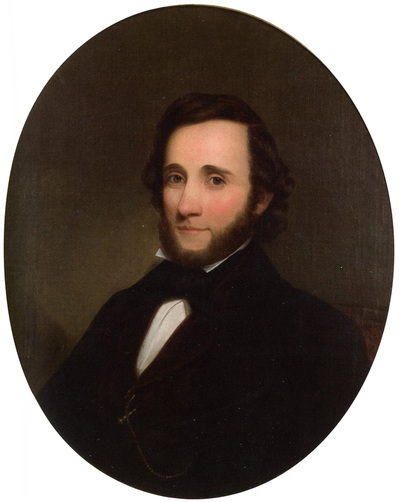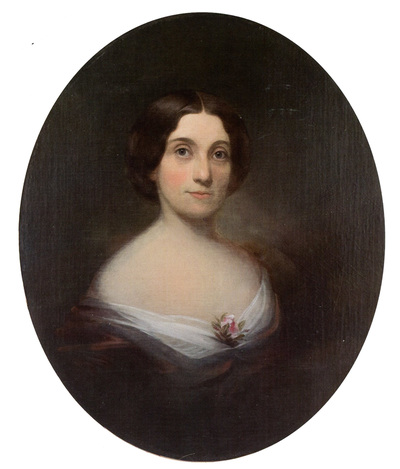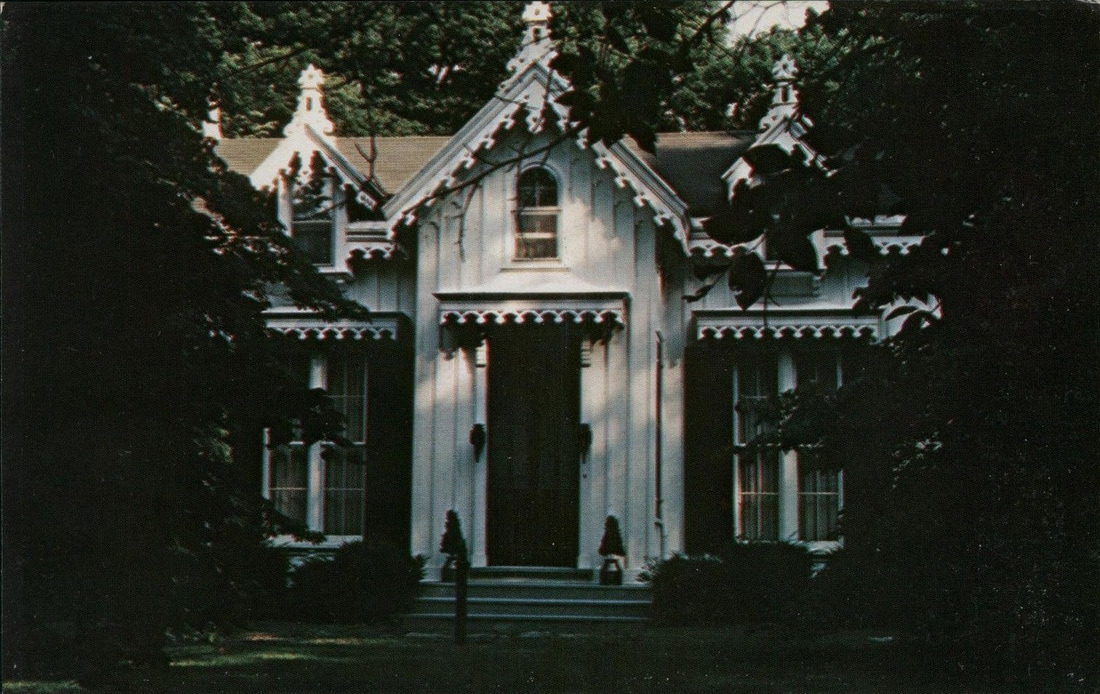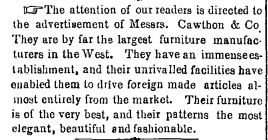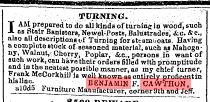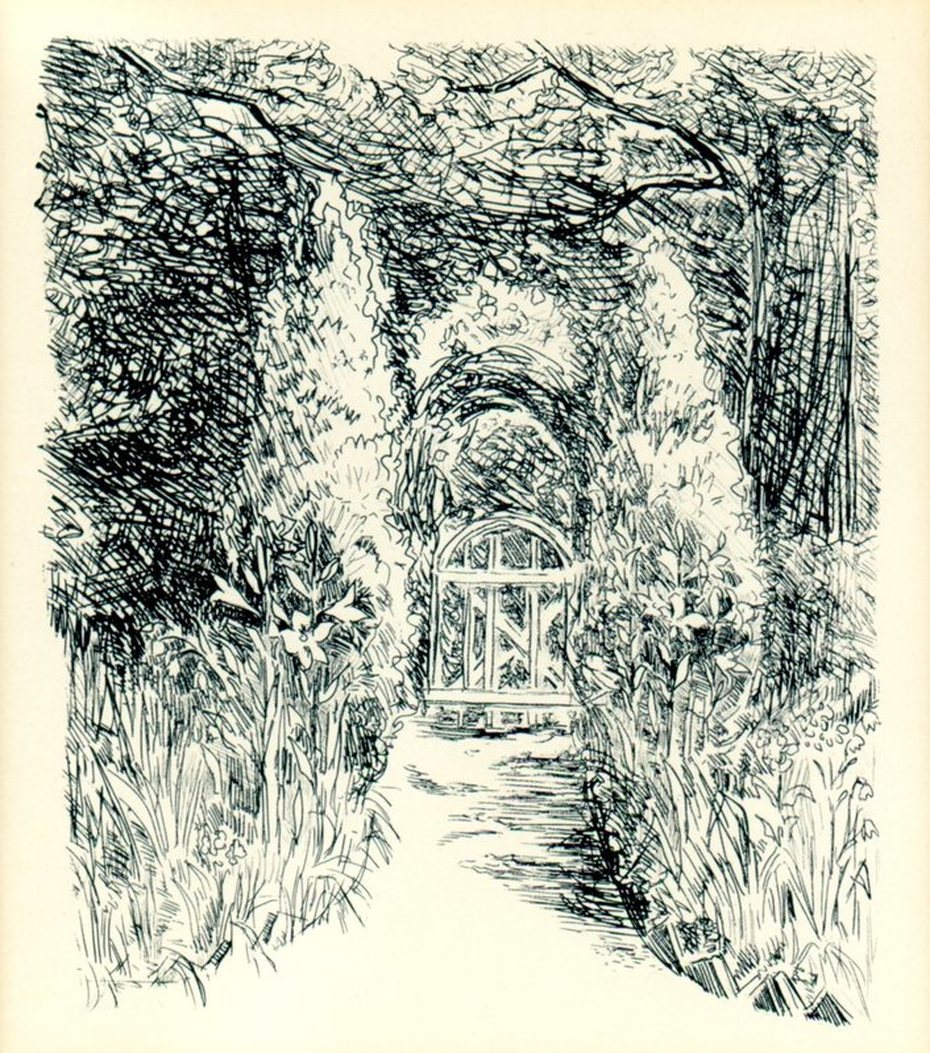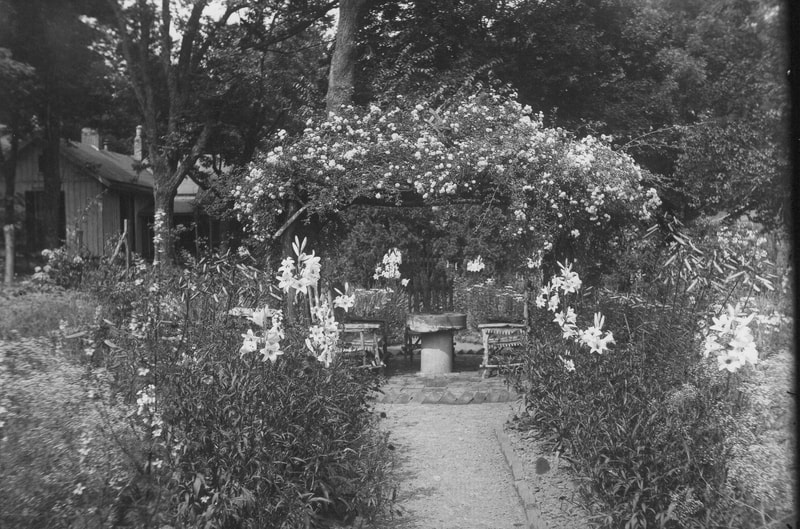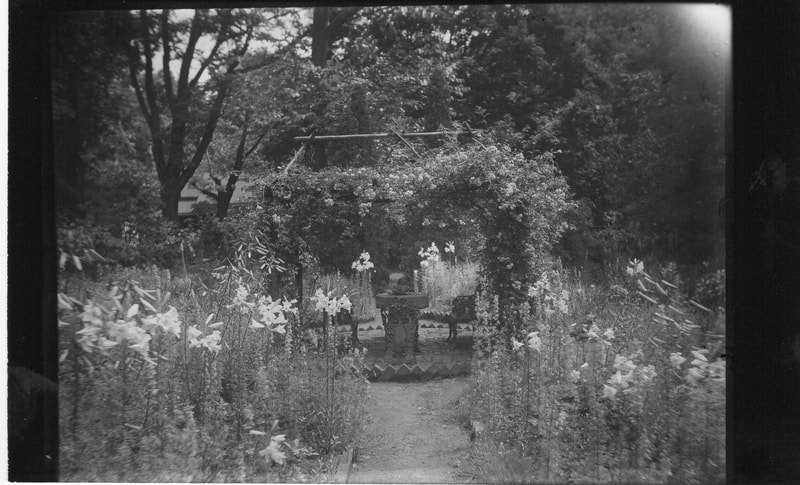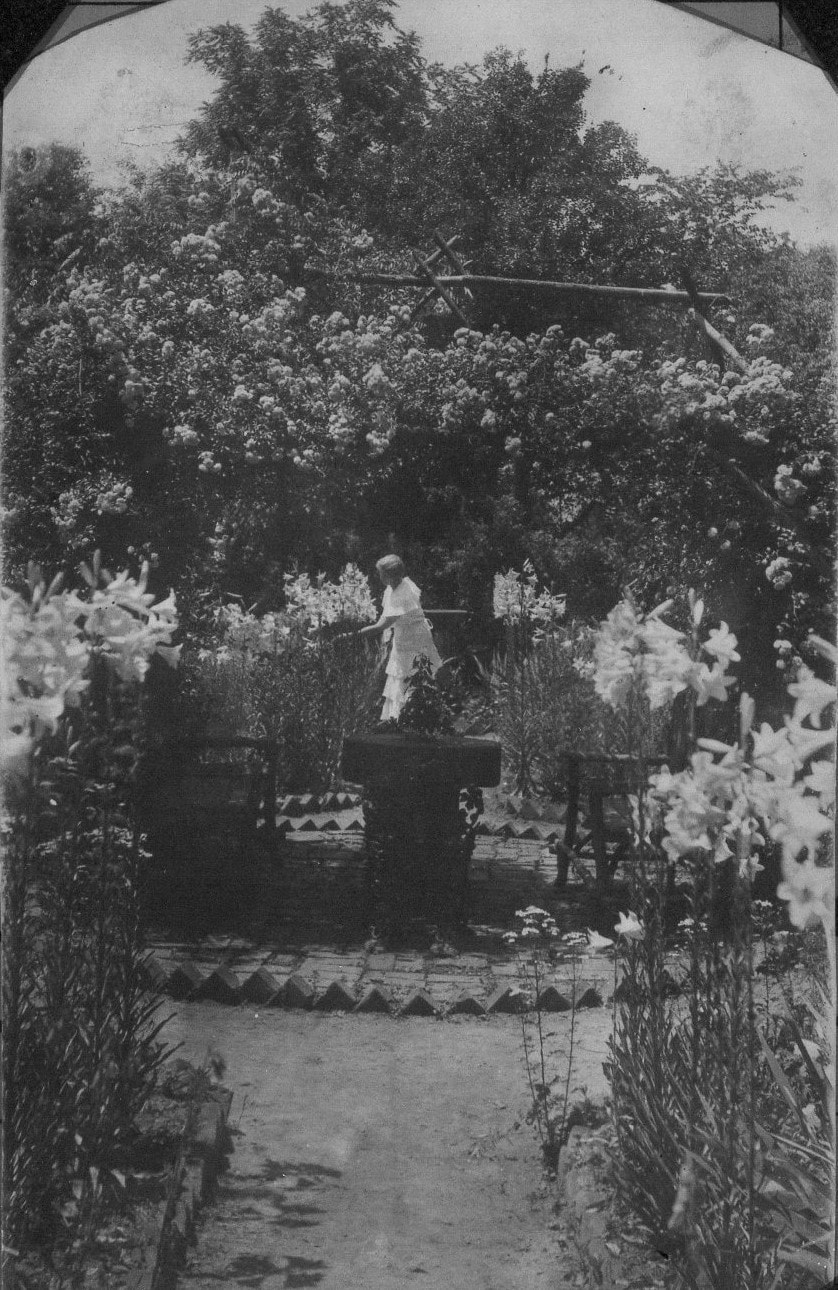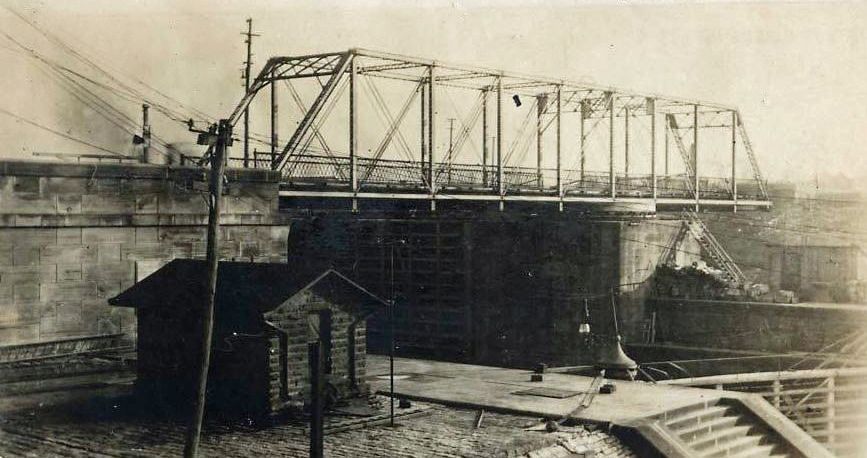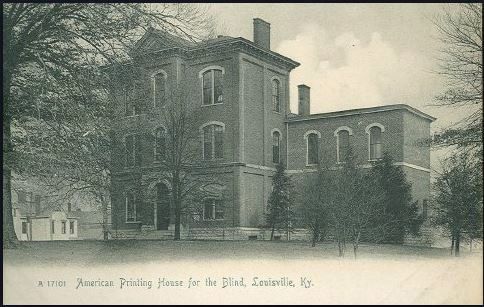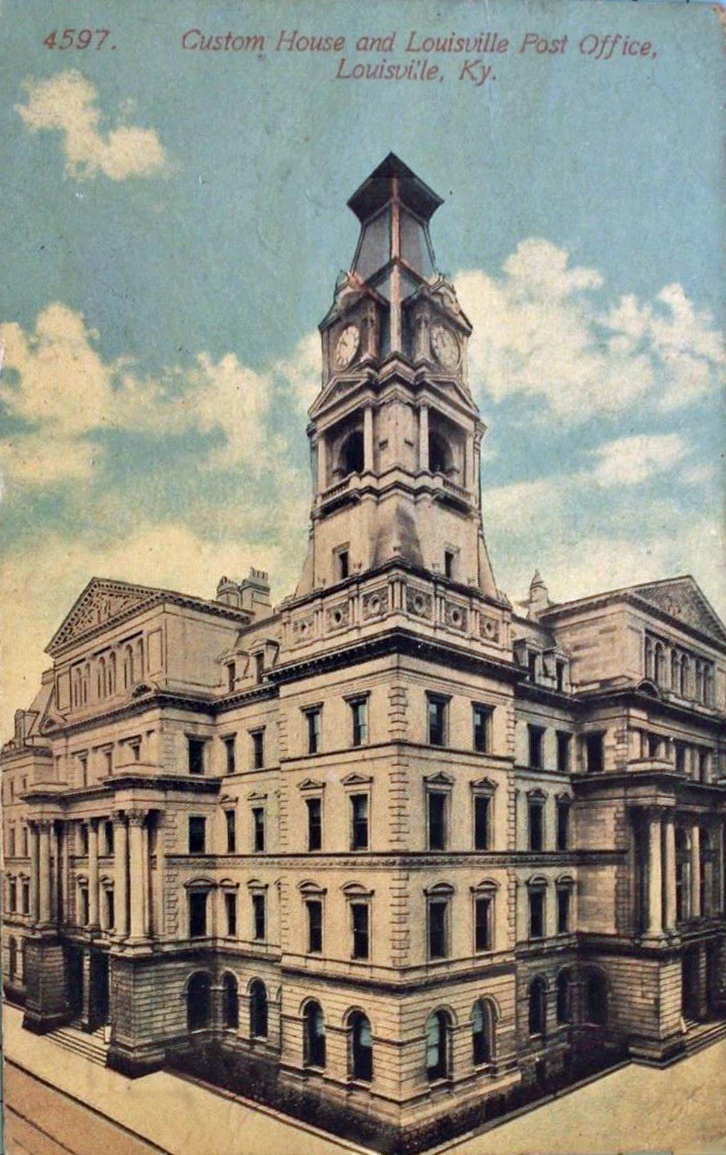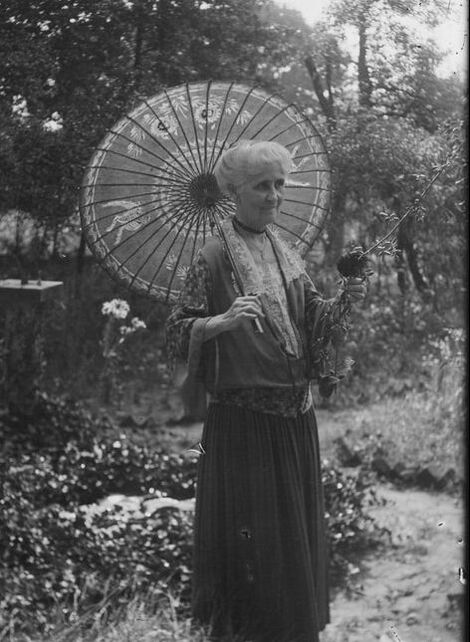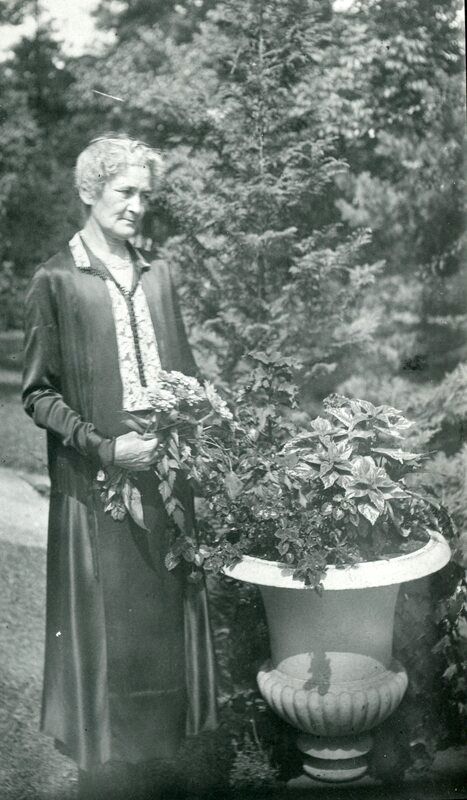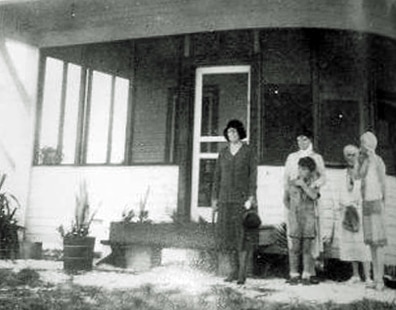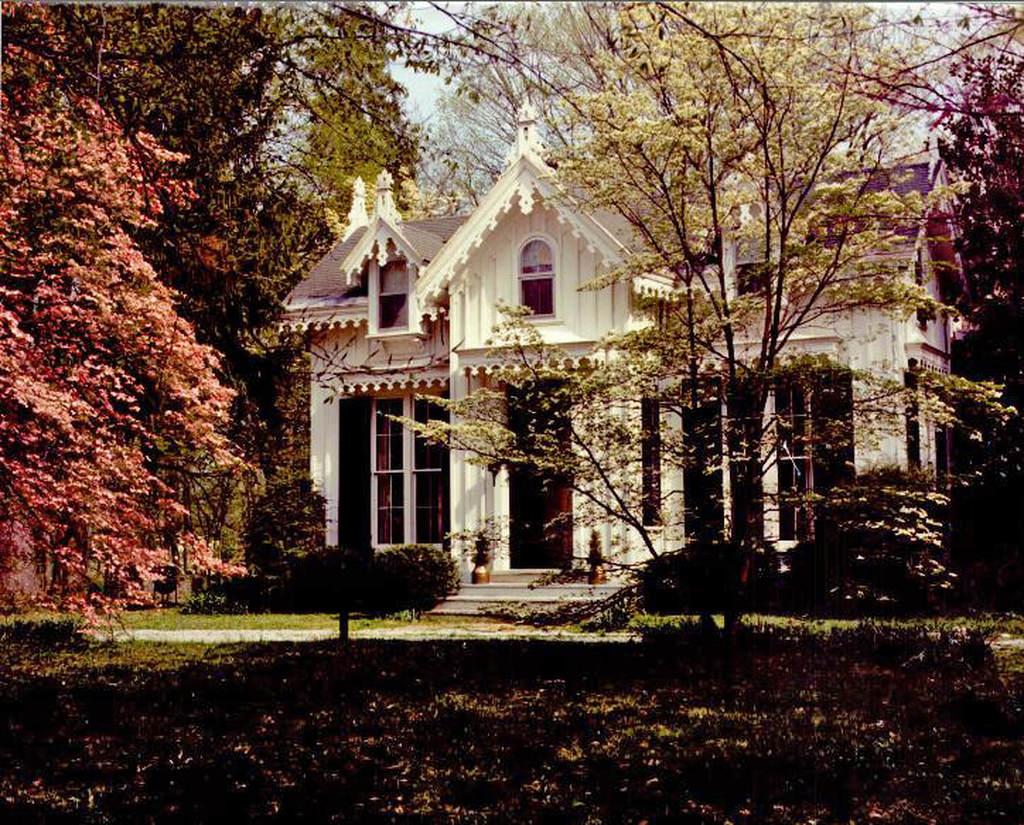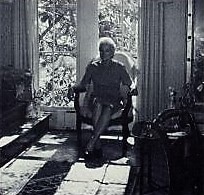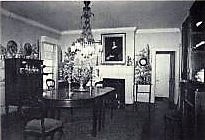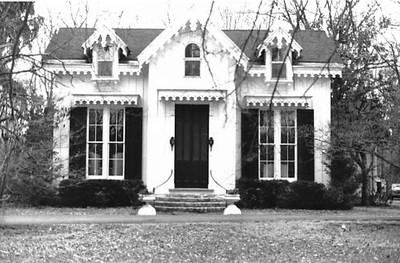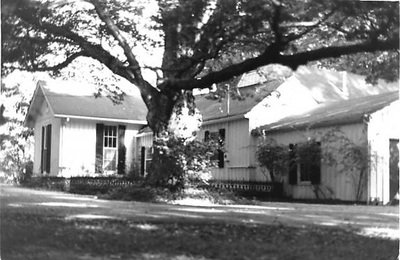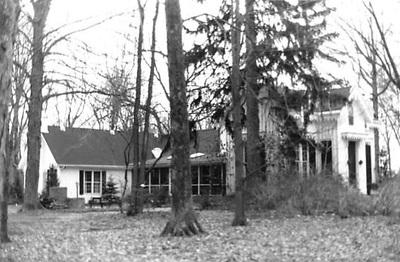Tuliphurst: The Dulaney Years & Beyond
The Dulaney Years: 1864-1944
Though Tuliphurst survives today as one of the earliest remaining structures from Pewee Valley’s first period of suburban development, it looks nothing like it did when Noble Butler was King. In 1864, the house and acreage were purchased by wealthy Louisville businessman Woodford Hector Dulaney. He turned the simple cottage with its many small porches into a much larger, Gothic Revival, summer home featuring picturesque board-and-batten siding, Valentine-style gingerbread and a steeply-pitched gable roof. During the winter, the family lived in their Louisville mansion on W. Broadway. It was so large, it became a local landmark and was later converted to the Welsworth hotel.
 Louisville impressionist and art critic Patti Prather Thum purportedly found the beech trees on Tuliphurst's lawn "a never-failing delight to paint," according to Briney's 1926 interview with Florence Dulaney Willis.
Louisville impressionist and art critic Patti Prather Thum purportedly found the beech trees on Tuliphurst's lawn "a never-failing delight to paint," according to Briney's 1926 interview with Florence Dulaney Willis.
In her June 27, 1927 Courier-Journal on Tuliphurst, Melville Otter Briney interviewed Mrs. Florence Dulaney Willis about the improvements her father, Woodford H. Dulaney, made to the estate:
... Mr. Dulaney did much to beautify the place after purchasing it. To the original three-room home, he made extensive additions, until today there are on the grounds, besides the house itself and a guest house, formerly Butler's study, the kitchen and slave quarters, the carriage house and the barn. Mr. Dulaney planted many of the wonderful trees from which the place takes its name of "Tuliphurst," and had the drives and walks laid off by some of the most distinguished landscape architects of the day. In the back of the estate, some distance from the house, is a spring of cold water that has been used ever since the house was occupied. The garden today is in the exact spot where the first flower garden was laid out, and surrounded by flowers of all kinds is a little sunken pool, and nearby a 115-year-old sundial taken from the farm of Judge Joseph Holt, Judge Advocate General in President Lincoln's Cabinet.
An early recollection of Mrs. Willis is of the Confederate soldiers who, during the War Between the States, camped on her father's grounds. She remembers, too, her first visits to the "Valley" when the family rose at an early hour, packed themselves into a carriage with impedimenta for a long journey, and slowly jogged for four hours along the road from Louisville to Pewee Valley...
Emma Loving offered some additional details about Tuliphurst's interior during the Dulaney family's ownership in the September 1, 1940 Courier-Journal:
... The house is charming. It has two front doors which open directly into two front rooms which adjoin without any partition. The floors are laid in a pattern unique in this part of the world. When Mrs. Willis was a child of 5, her parents went on a trip to Europe ... and in the course of their travels they went to Rome. There her father, Mr. W.H. Dulaney, saw in a palace a most beautiful parquetry and he took out his pencil and drew a pattern of it.
When he bought the house in Pewee Valley, he added the two front rooms and had the floor laid down in the pattern that he had drawn. The floor is remarkable in that it is composed of solid blocks of light and dark wood, each as deep as it it wide so that the floor is very firm. They were laid in 1860 and are just as good as new.
The drawing room windows are hung with handsome red satin curtains with a wide floral border. These curtains were bought in 1871, and there is not a break in them...
... Mr. Dulaney did much to beautify the place after purchasing it. To the original three-room home, he made extensive additions, until today there are on the grounds, besides the house itself and a guest house, formerly Butler's study, the kitchen and slave quarters, the carriage house and the barn. Mr. Dulaney planted many of the wonderful trees from which the place takes its name of "Tuliphurst," and had the drives and walks laid off by some of the most distinguished landscape architects of the day. In the back of the estate, some distance from the house, is a spring of cold water that has been used ever since the house was occupied. The garden today is in the exact spot where the first flower garden was laid out, and surrounded by flowers of all kinds is a little sunken pool, and nearby a 115-year-old sundial taken from the farm of Judge Joseph Holt, Judge Advocate General in President Lincoln's Cabinet.
An early recollection of Mrs. Willis is of the Confederate soldiers who, during the War Between the States, camped on her father's grounds. She remembers, too, her first visits to the "Valley" when the family rose at an early hour, packed themselves into a carriage with impedimenta for a long journey, and slowly jogged for four hours along the road from Louisville to Pewee Valley...
Emma Loving offered some additional details about Tuliphurst's interior during the Dulaney family's ownership in the September 1, 1940 Courier-Journal:
... The house is charming. It has two front doors which open directly into two front rooms which adjoin without any partition. The floors are laid in a pattern unique in this part of the world. When Mrs. Willis was a child of 5, her parents went on a trip to Europe ... and in the course of their travels they went to Rome. There her father, Mr. W.H. Dulaney, saw in a palace a most beautiful parquetry and he took out his pencil and drew a pattern of it.
When he bought the house in Pewee Valley, he added the two front rooms and had the floor laid down in the pattern that he had drawn. The floor is remarkable in that it is composed of solid blocks of light and dark wood, each as deep as it it wide so that the floor is very firm. They were laid in 1860 and are just as good as new.
The drawing room windows are hung with handsome red satin curtains with a wide floral border. These curtains were bought in 1871, and there is not a break in them...
The Woodford H. Dulaney Family
Margaret and Woodford Dulaney had ten children, but many of them died young, according to descendant Sue Beach, who has been researching her family genealogy:
- Florence Braden Dulaney Willis (November 17, 1851-June 5, 1944)
- Charles Cawthon Dulaney, (June 17-1854-September 6, 1855)
- Margaret "Maggie" Woodford Dulaney (June 27, 1856-June 29, 1857)
- Woodford Hector Dulaney, Jr. (November 29, 1858-May 20, 1903)
- Margaret Josephine Dulaney (June 15, 1860-September 27, 1879)
- Robert Lee Dulaney (April 1, 1865-June 30, 1893)
- Elizabeth Elinor (“Lizzie”) Dulaney Clements (November 11, 1866-December 29, 1956)
- Benjamin C. Dulaney (October 19, 1869-August 25, 1899)
- Mary Maud Dulaney (March 12, 1870-March 7, 1872)
- May Dulaney (May 18, 1872-July 9, 1942)
The Dulaney Fortune
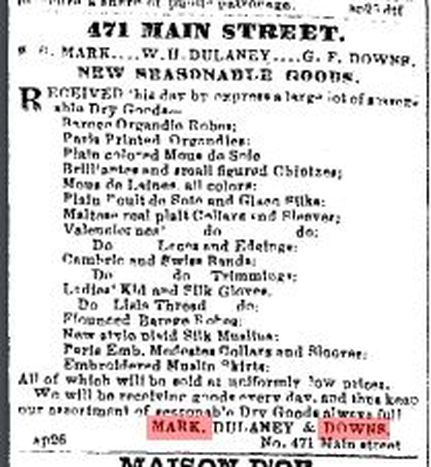 Louisville Courier, April 26, 1854
Louisville Courier, April 26, 1854
Woodford Dulaney earned one fortune and inherited a second. His first fortune was the result of working his way up the ladder in the retail dry goods trade. After arriving in Louisville ca. 1840, he clerked for the house of J. Raphael, which operated Louisville's largest retail store, Maison D'Or. In 1851, Maj. G.F. Downs, Woodford Dulaney and a third clerk, Samuel S. Mark, staged a coup. They left Maison D'Or to form their own, competing dry goods concern, Mark, Dulaney & Downs. The new store was located on Main Street between Fourth and Fifth and the January 19, 1853 Daily Courier ran this glowing description of their new building:
Splendid Building and Dry Goods House
Among the many beautiful and important improvements that have, during the past year, transpired in our city, none, we can safely say, have added more to its adornment and character than the building recently erected and now occupied by Mssrs. Mark, Dulaney and Downs. The house, in point of size and style, is entirely different than any heretofore erected, being built of handsome free stone, of the Doric order of architecture, attaining a height, including four stories, of seventy feet.
The lower floor has been handsomely and appropriately arranged, and fitted up for the sale of Dry Goods in all their variety, from the common brown cotton to the richest venetian velvets or most costly silks and satins. This room embraces an area of 183 feet depth by 24 feet width by 15 feet heighth. On each side is arranged shelving for disposal of goods, which is both neat and pretty. The counters are well arranged, having permanent seats for the ladies to occupy while purchasing or examining goods; in the center of the room is a receiver's desk. so arranged as to be readily accessible to all salesmen in the store, to whom all monies for goods sold are paid, and who alone is responsible to the firm. Immediately over this place is a large sky-light which gives an abundance of the light to the room which otherwise wood be dark and dreary. At the extremity of the room is a large mirror, seven by four feet, so placed as to give an unending perspective view; this mirror is beautifully ornamented with composition and gilt work, while over the top is set a large dial clock.
The entrance to the store is large, open front, built of cast iron, having one large show window on each side, of six feet depth, embellished with two fine and splendid French plates of glass, measuring 109 inches by 36 inches to each window. Immediately over the entrance is displayed in magnificent style of block letters, the name of the enterprising firm, Mark, Dulaney & Downs.
The painting of the interior, which is of zinc white, as well as the work on the mirror and the sign, were executed by I.C. Miller & Co.
The second story consists of a room 100 feet deep, which is arranged and fitted up for the sale of Carpets in all their qualities.
The third story has been divided into suitable rooms for office of all kinds, and in one we found the Mercantile Agency, and in another, a lawyer's office; these rooms are large, light and airy.
The walls throughout the entire building are frescoed in lieu of being papered.
The brick work of the above building was erected by Mr. Shanks. and the stone work by J.A. Powers; the carpenter's work and cast iron front by S.P. Snead & Co.; the whole being done under the superintendence of Gideon Schyrock, the architect. The building is one that reflects great credit upon the mechanics engaged upon its construction, and, we trust, will ? not less the the pecuniary advancement of the enterprising owners.
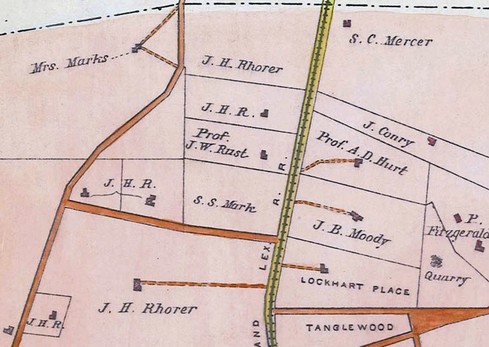 In 1870, Samuel S. Mark owned property beside The Locust
In 1870, Samuel S. Mark owned property beside The Locust
S.Further details about the store were included in G.F. Downs' obituary, which ran in the August 21, 1908 Courier-Journal:
...The success of the firm was marvelous, and Maj. Downs was selected as the New York buyer. He spent six months of each year there, and became one of the most expert buyers in the dry good business. He could close his eyes and by the touch of his fingers could tell instantly the quality of the goods...
Woodford H. Dulaney retired from the firm (editor's note: He retired in 1856, according to Josiah Stoddard Johnston's "Memorial History of Louisville from Its First Settlement to the Year 1896, Volume 1") and Mark & Downs changed the location of their business to Fourth avenue and Jefferson street...and continued in business until the close of the Civil War....
Nothing is known about what became of the third partner, Samuel S. Mark. Before starting his retail career, he appears to have served as a U.S. Postal clerk in 1841, based on the Official Register of the United States: Containing a List of Persons Occupying Administrative and Supervisory Positions in the Legislative, Executive and Judicial Branches of the Government, Including, Part 3, published by United States Civil Service Commission Superintendent of Documents., 1843, page 596.
Samuel owned property at one time in Pewee Valley. An ad for the sale or rent of his Pewee Valley tract appeared in the January 3, 1868 Daily Courier and described the property as follows:
FOR SALE OR RENT -- FARM -- My farm of about 480 acres, in Oldham county, near Smith's Station (or Pewee Valley, Ky.) The place is well watered, a good hay farm, and has two fine orchards. Apply to S.S. MARK, Esq., near Beard's Station (editor's note: known today as Crestwood)...
Samuel was among the supporters of the Kentucky College for Young Ladies, when it was established in 1870.
...The success of the firm was marvelous, and Maj. Downs was selected as the New York buyer. He spent six months of each year there, and became one of the most expert buyers in the dry good business. He could close his eyes and by the touch of his fingers could tell instantly the quality of the goods...
Woodford H. Dulaney retired from the firm (editor's note: He retired in 1856, according to Josiah Stoddard Johnston's "Memorial History of Louisville from Its First Settlement to the Year 1896, Volume 1") and Mark & Downs changed the location of their business to Fourth avenue and Jefferson street...and continued in business until the close of the Civil War....
Nothing is known about what became of the third partner, Samuel S. Mark. Before starting his retail career, he appears to have served as a U.S. Postal clerk in 1841, based on the Official Register of the United States: Containing a List of Persons Occupying Administrative and Supervisory Positions in the Legislative, Executive and Judicial Branches of the Government, Including, Part 3, published by United States Civil Service Commission Superintendent of Documents., 1843, page 596.
Samuel owned property at one time in Pewee Valley. An ad for the sale or rent of his Pewee Valley tract appeared in the January 3, 1868 Daily Courier and described the property as follows:
FOR SALE OR RENT -- FARM -- My farm of about 480 acres, in Oldham county, near Smith's Station (or Pewee Valley, Ky.) The place is well watered, a good hay farm, and has two fine orchards. Apply to S.S. MARK, Esq., near Beard's Station (editor's note: known today as Crestwood)...
Samuel was among the supporters of the Kentucky College for Young Ladies, when it was established in 1870.
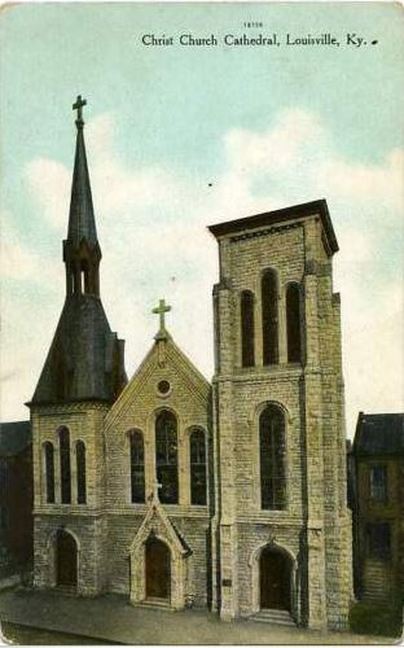
Woodford Dulaney came into his second fortune through his February 4, 1851 marriage to Margaret Cawthon. Ben Cawthon, her father, had owned a brickyard in Louisville and among other construction projects, supplied the bricks for Christ Church, where Noble Butler's funeral service was held. He had also owned a large parcel of land south of Broadway known as "Cawthon's Addition." That land had naturally increased in value as the city grew, but with the coming of the Louisville & Nashville railroad, became a prime location for commercial development, just as Louisville's riverfront was when the city was founded.
On October 11, 1851, the Daily Courier ran a story titled -- ironically enough -- "Our Rich Men," that listed Louisville's 1851 property valuations. Although a few of Louisville's very oldest families owned land worth more -- James Guthrie, James Rudd, John Jacob, William Prather -- Margaret and her brother, Ben F., were property-rich by most standards:
EASTERN DISTRICT
Cawthon, Margaret J. $81,440
Cawthon, B.F. $33,700
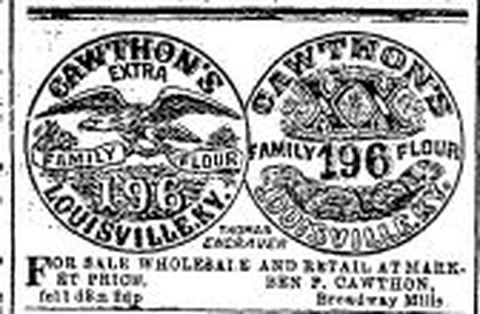 Louisville Daily Courier, February 29, 1860
Louisville Daily Courier, February 29, 1860
Before she died, Margaret also inherited from her brother. At one time he had owned Louisville's largest furniture manufacturing plant at Ninth and Jefferson. And in 1856, Woodford and Ben had gone into the flour milling business together, according to the March 28, 1856 Daily Courier:
Town Trifles
Among the very many improvements which are now progressing throughout the city is one of great importance to the agricultural and manufacturing interests. It is a large
Flouring Mill
on the corner of Tenth and Broadway, just opposite the depot of the Nashville railroad. Our enterprising citizen, W.H. Dulaney, Esq., is erecting the mill, which will be equipped and conducted by Ben F. Cawthon, a gentleman well-known in this city. The mill is to be four stories high, with an attic, and constructed after the most scientific principles. There will be three run of stone, affording an extraordinary capacity for grinding. The machinery is to be of the latest and most perfect patterns, while the entire will be a model of the inventive skill and ingenuity of man. Mr. F.W. Vogdes is the architect and superintendent of construction. He intends that this establishment shall be a monument to his talent and skill. The location of this mill may be considered rather remote from the business portions of the city. It will, however, have the advantage of being in immediate proximity to the Nashville depot, and of course will have the first offer of all grain that will be received by that route. Indeed this is but one of the establishments which will inevitably cluster about the terminus of our great railroad. No section of the city promises to be the scene of so much activity and business as that surrounding the Nashville depot...
The mill opened in September 1856.
Ben died with no close relatives, according to his obituary, which ran in the Courier-Journal on May 9, 1899:
OLD CITIZEN DEAD
_____________________
Benjamin Cawthon Passes Away At
His Country Home --Funeral This Morning
Benjamin F. Cawthon died at his home near Draco Station on the Southern Railway early Sunday afternoon of a complication of diseases. He was seventy years old and was born and reared in Louisville. In 1848, when only twenty-two years of age, he and Lochlan McDougal built a large furniture factory at Ninth and Jefferson streets. About ten years later, Mr. Cawthon built a flour mill at Tenth and Broadway, where the Union Station now stands. For the past ten or fifteen years, he has been engaged in farming in the county. He had only one near relative, Mrs. W.H. Dulaney, his wife and two sons having died several years ago. His body was brought to the home of W.H. Dulaney in this city yesterday morning, and the funeral will take place at the residence this morning at 10 o'clock. The remains will be buried in Cave Hill Cemetery.
Town Trifles
Among the very many improvements which are now progressing throughout the city is one of great importance to the agricultural and manufacturing interests. It is a large
Flouring Mill
on the corner of Tenth and Broadway, just opposite the depot of the Nashville railroad. Our enterprising citizen, W.H. Dulaney, Esq., is erecting the mill, which will be equipped and conducted by Ben F. Cawthon, a gentleman well-known in this city. The mill is to be four stories high, with an attic, and constructed after the most scientific principles. There will be three run of stone, affording an extraordinary capacity for grinding. The machinery is to be of the latest and most perfect patterns, while the entire will be a model of the inventive skill and ingenuity of man. Mr. F.W. Vogdes is the architect and superintendent of construction. He intends that this establishment shall be a monument to his talent and skill. The location of this mill may be considered rather remote from the business portions of the city. It will, however, have the advantage of being in immediate proximity to the Nashville depot, and of course will have the first offer of all grain that will be received by that route. Indeed this is but one of the establishments which will inevitably cluster about the terminus of our great railroad. No section of the city promises to be the scene of so much activity and business as that surrounding the Nashville depot...
The mill opened in September 1856.
Ben died with no close relatives, according to his obituary, which ran in the Courier-Journal on May 9, 1899:
OLD CITIZEN DEAD
_____________________
Benjamin Cawthon Passes Away At
His Country Home --Funeral This Morning
Benjamin F. Cawthon died at his home near Draco Station on the Southern Railway early Sunday afternoon of a complication of diseases. He was seventy years old and was born and reared in Louisville. In 1848, when only twenty-two years of age, he and Lochlan McDougal built a large furniture factory at Ninth and Jefferson streets. About ten years later, Mr. Cawthon built a flour mill at Tenth and Broadway, where the Union Station now stands. For the past ten or fifteen years, he has been engaged in farming in the county. He had only one near relative, Mrs. W.H. Dulaney, his wife and two sons having died several years ago. His body was brought to the home of W.H. Dulaney in this city yesterday morning, and the funeral will take place at the residence this morning at 10 o'clock. The remains will be buried in Cave Hill Cemetery.
Death of Margaret Cawthon Dulaney
Margaret Cawthon Dulaney's death and will received extensive coverage in the local papers. The Courier-Journal ran the following obituary on January 31, 1901:
MRS. DULANEY DEAD
______________________________
ONE OF THE BEST-KNOWN WOMEN
IN LOUISVILLE
______________________________
Would Have Celebrated Golden Anni-
versary of Wedding On
February 4
______________________________
OLD AGE'S COMPLICATIONS
Mrs. W.H. Dulaney, sixty-nine years old, died of a complication of diseases incident to old age at her home, 729 West Broadway, yesterday afternoon at 4 o'clock. Mrs. Dulaney had been an invalid for more than a year, and her condition has been critical for the past four or five weeks.
Mrs. Dulaney's maiden name was Margaret Josephine Cawthon, and she was the daughter of Benjamin Cawthon, a well-known brick manufacturer. Her marriage to Mr. Dulaney was solemnized on February 4, 1851 and had she lived until Monday they would have celebrated the fiftieth anniversary of their marriage.
She is survived by her husband who until a few years ago was a prominent merchant of Louisville and who owns a great deal of real estate in the city. Four children, Mrs. Albert S. Willis, whose husband represented this district on Congress and served at the United States Minister to Hawaii during President Cleveland's first term; Hector Dulaney, a well-known lawyer; Mrs. Lizzie D. Clements, wife of Judson C. Clements, of the Interstate Commerce Commission and May Dulaney. Mrs. Clements was with her mother during her illness, but was called to her home in Washington by the sudden illness of her daughter.
Mrs. Dulaney was a member of St. Paul's Episcopal Church and was active in charitable work.
The funeral services will be held at the residence tomorrow morning at 11 o'clock and the burial will be at Cave Hill Cemetery.
It took three years to settle her estate, which consisted entirely of property. The July 26, 1904 Courier-Journal reported that it was appraised at $345,259.30 -- about $9.3 million in today's dollars -- and was divided equally among her heirs as follows:
- May Dulaney, 14 pieces
- Florence Dulaney Willis, 16 pieces
- Lizzie Dulaney Clements, 12 pieces
- Henrietta Dulaney, only child of Woodford Dulaney, Jr., who died in May 1920, and Caroline Fulton; 18 pieces
- Fidelity Trust Company, as trustee of Woodford H. Dulaney, son of the late Robert Lee Dulaney and Anna B. McAfee, 12 pieces
Death of Woodford H. Dulaney
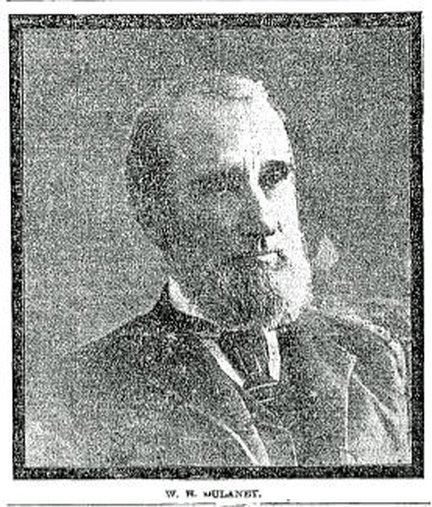
Several biographical sketches of Woodford Dulaney are available. This one is from "America's successful men of affairs. An encyclopedia of contemporaneous biography" published by the New York Tribune:
WOODFORD HECTOR DULANEY, a property owner, Louisville, Ky., was born in Loudon county, Va., May 16, 1822, the son of Zachariah Dulaney, a school teacher and farmer, who, in turn, was the son of Leroy, son of William, son of William Dulaney, who settled in Bellhaven, now Alexandria, Va., in 1700. The young man received a common school education and took his place in the world of affairs as a merchant in the dry goods business. He removed to Louisville in January, 1841, where he soon became conspicuous in judicious investments in real estate and good management of the property inherited by his wife, Margaret Josephine Cawthon, to whom he was married in 1851. Mr. Dulaney was several times elected to the General Council of the city of Louisville, and has been president of The Elizabeth Town & Paducah Railroad, The Cumberland & Ohio Railroad, and The Kentucky National Bank, and is now serving his twentieth year as director of The Bank of Kentucky. He was president of the Kentucky board of managers of the World's Columbian Exposition. His five children are, Florence, wife of Albert S. Willis, Minister to the Hawaiian Islands; Hector; Benjamin; Lizzie, wife of Judson C. Clements, member of the Interstate Commerce Commission, and May. Mr. Dulaney is the largest individual tax payer in the city of Louisville.
However, his obituary, published in the December 20, 1902 Courier-Journal, contains much more detail about his business interests and personal life:
Woodford Hector Dulaney, for many years one of Louisville’s foremost capitalists, besides being president of the Kentucky Commission for the World’s Columbian Exposition held at Chicago in 1893, died yesterday (December 19, 1902) at 1:30 o’clock at his residence, 720 West Broadway. The illness to which he finally succumbed dates back to a year ago this month, when he contracted a severe case of grip, which was prevalent at that time. Though at intervals he managed to regain something of his former strength, he was frequently ill and months ago the members of his family and his friends realized that the end could not be far away. The immediate cause of Mr. Dulaney’s death was inflammation of the bladder, which developed about ten days ago. Mr. Dulaney was perfectly conscious and able to converse with those about him until shortly before the end. He sank as peacefully as if falling to sleep and died to all appearances without suffering. With him were two of his daughters, Mrs. Albert S. Willis and Miss May Dulaney, and his son, W. Hector Dulaney. His third daughter, Mrs. Judson Clements, of Rome, Ga., was unable to be here on account of having an ill child.
Only Recently Retired
Mr. Dulaney was eighty-one years of age, and of course the infirmities of old age told heavily upon him when his health was broken by the first attack a year ago. He bore up under his failing health with great patience and almost to the last took a keen interest and an active hand in the conduct of his affairs. It was not two years ago when he severed his last connection with active business life. This was his resignation from the directorate of the National Bank of Kentucky, in which he had held a place continuously for upward of twenty-five years. Until his illness a year ago Mr. Dulaney had known but little ill health throughout the whole course of his life. The members of his family say that they cannot remember when he was ill before. Always a temperate man, he built up a constitution of iron.
After rallying from the worst of his last winter’s attack of the grip, he went to Palm Beach in the hope of regaining his strength. The change, however, did not appear to be of any special benefit to him, and he continued to slowly lose his remaining strength. After remaining at Palm Beach until shortly after March 1, he returned home. A severe attack of rheumatism in the lower limbs which he first sustained while in Florida continued to develop after his arrival here. The return trip told heavily upon him, and it was all he could do to get home. From that time he was confined to his home steadily, with the exception of a few short intervals, until about July 1. He and his family then removed to their summer home in Pewee Valley, and during August and September he began to show slight signs of improvement. With the return of winter, he began to be troubled once more with rheumatic attacks, and complications followed. On account of his illness the family did not move from the city from their country home until December 4. Since then, Mr. Dulaney grew steadily worse until death finally came to his relief.
Prominent Business Man
Mr. Dulaney has been closely identified with the city’s business interests, both financial and mercantile for fully half a century. He made his first fortune in the dry goods business before the war, and had always held large interest in two or three of the city’s most prominent banking institutions and bought a great deal of real estate, much of which he improved and sold at a profit. At the time of his death he was one of Louisville’s heaviest owners of land and houses. His rent roll was probably one of the largest in the city. He was a promoter and official of one railroad. Besides these greater affairs he always had in hand a number of smaller interests, and always gave every item of his business that minute attention which marks the man with a genius for business.
A Strong Democrat
Though possessing an unusually wide circle of acquaintances he belonged to no club or fraternity. Quiet and unassuming, he always made his own fireside his club, though from the first was popular with all classes of men in business. He took an active interest in both city and national politics, being a strong Democrat. He was especially interested in municipal affairs, and with his true business instincts possessed many excellent ideas upon the administration of civic affairs. Only once was he a candidate for municipal office. It was when he was elected to the Board of Aldermen a number of years ago.
Work for Columbian Exposition
Mr. Dulaney probably attained his greatest prominence in the world of affairs by his administration of the Kentucky Commission to the World’s Columbian Exposition. This board was appointed by former Governor Brown in 1892, and Mr Dulaney was selected by his associates as its chief officer. Associated with him on the board were Commissioner of Internal Revenue John W. Yerkes, former Congressman Clardy and Judge J.D. Black. Notwithstanding many errors and delays of legislation, Kentucky’s showing at the exposition was pronounced by all as an unqualified success. This success was largely due to Mr. Dulaney’s untiring work and his extraordinary ability to conduct such an enterprise. On account of certain litigation, the cause for which originated during the progress of the exposition, the commission was long delayed making its final report to the Governor. This report was presented about a year ago and in a straightforward manner set forth the great work that had been accomplished. It also turned over to the State about $25,000 of the appropriation which the Legislature had allowed it with which to carry on work. So well had the affairs been conducted that Mr. Dulaney had been able to save $25,000 of the State’s money and return it to the treasury. This matter was commented upon by the press of the country, and upon Mr. Dulaney was conferred all the praise his work so well merited.
Surviving Relatives
Mr. Dulaney leaves four children and a brother and sister, both older than himself. His wife died several years ago. His living children are Mrs. Albert S. Willis, the widow of the late Hon. Albert S. Willis, former member of Congress and Minister to Hawaii; Mrs. Judson Clements, wife of former Congressman Clements, of Georgia and now a member of the Interstate Commerce Commission; W. Hector Dulaney of this city; and Miss May Dulaney. His brother, Robert L. Dulaney, makes his home at Marshall, Ill. His sister is Miss Lizzie Dulaney, of this city. In all Mr. Dulaney had ten children, six of whom are dead. They were Margaret Josephine, who died in 1879; Robert L., who died in 1899; Benjamin Cawthon, who died in 1899; and Charles Cawthon, Maggie Woodford and Mary Maud, who died in infancy. Mr. Dulaney leaves six grandchildren. Albert Willis, Jr., now at Yale University; Henrietta Dulaney, daughter of W. Hector Dulaney; Woodford H. Dulaney, son of the late Robert Dulaney, and Clementine Elizabeth, Margaret Dulaney and Mark Park Clements, daughter of Mrs. Judson Clements. Aside from those now living, Mr. Dulaney had another sister and a brother. They were Mary E., wife of Dr. J.W. Martin, of Brookhaven, Miss., who died in 1880, and Charles F. Dulaney, who died more than thirty years ago in California.
Virginian By Birth
Mr. Dulaney was a Virginian by birth, being born in Loudoun country, which is in the northern part of that state. His parents were Zachariah and Mary Eleanor Braden Dulaney, who came from families which had long made their homes in the tide-water district of Virginia. They were of Irish descent, their ancestors having come over to Virginia in 1700 at the period of political agitation which resulted in the immigration to America of a large number of the best citizens of Ireland. They settled first at Alexandria, near Washington, which was then the principal seaport of the State. Mr. Dulaney received his early education at the country schools in Loudoun County and commenced his commercial career at the age of fourteen as a clerk at a dry goods and grocery store in the village of Waterford, Va. He soon attracted attention to himself by his ability and secured not long afterward a better position in Leesburg, the county city of Loudoun county. Later he went to Washington, D.C., continuing in commercial pursuits.
Came To Louisville At Early Age
In the nineteenth year of his age he came to Louisville and landed here in 1840 without a friend and with no capital. Through letters he had with him he succeeded in obtaining a clerkship in the dry goods house of Sewell & Company, and shortly afterward won a still better position in the house of J.L. Raphael, known as “Maison d’Or.” It was then regarded as one of the largest and best establishments of its kind in the city. At that time the store was located on Main Street, between Fourth and Fifth. After few years in this firm, Mr. Raphael sold out his interests to Mr. Dulaney and two other clerks in his employ named Mark and Downs. These three conducted the business for a number of years under the firm name of Mark, Dulaney & Downs. In 1851 Mr. Dulaney married Miss Margaret Cawthon. For recreation from his close application to business he took a trip to Europe, remaining abroad for about eighteen months. He was accompanied by his wife and daughter. He returned to the city in about 1859 and continued to address himself to his large private interests. One of his principal enterprises was his management of the estate of Benjamin Cawthon, his father-in-law, who had died a few years before, naming him as executor of his will. Mr. Cawthon was one of Louisville’s wealthiest citizens, leaving large and varied interests, which required a number of years to be properly settled.
Held Prominent Positions
In spite of the heavy demand made upon his time by his many private affairs he was called upon by his fellow citizens to take an active part in the city government. However, he would only consent to run for the General Council, and he represented that body in 1861 and again in 1866 and 1867. During the progress of the Civil War he was always regarded as a Southern sympathizer, though he never took any active part in aiding the Confederacy and lived without bitterness or friction with the Union sympathizers of the city. Mr. Dulaney was a member of the first directorate of the Elizabethtown and Paducah railroad, later a part of the old Chesapeake and Ohio Southwestern and now owned by the Illinois Central. In 1870, he became president of the road and in 1874 he was elected president of the Cumberland and Ohio Railway Company. Upward of twenty years ago he became one of the board of managers of the Cave Hill Cemetery and held this position at the time of his death. For a short period of time he was president of the Bank of Commerce.
Many of Mr. Dulaney’s old business associates are dead. Among those closest to him during his long career were the late Thomas Barret, president of the Bank of Kentucky, in which Mr. Dulaney was a director for several years; the late S.S. Mark, who was his partner in the dry goods business before the war; G.F. Downs, also of that firm; John T. Moore, formerly of this city but now making his home in Chicago; George W. Morris and a number of others. His brother-in-law, Benjamin Cawthon, who died in 1899, was always closely associated with Mr. Dulaney, both in business and socially.
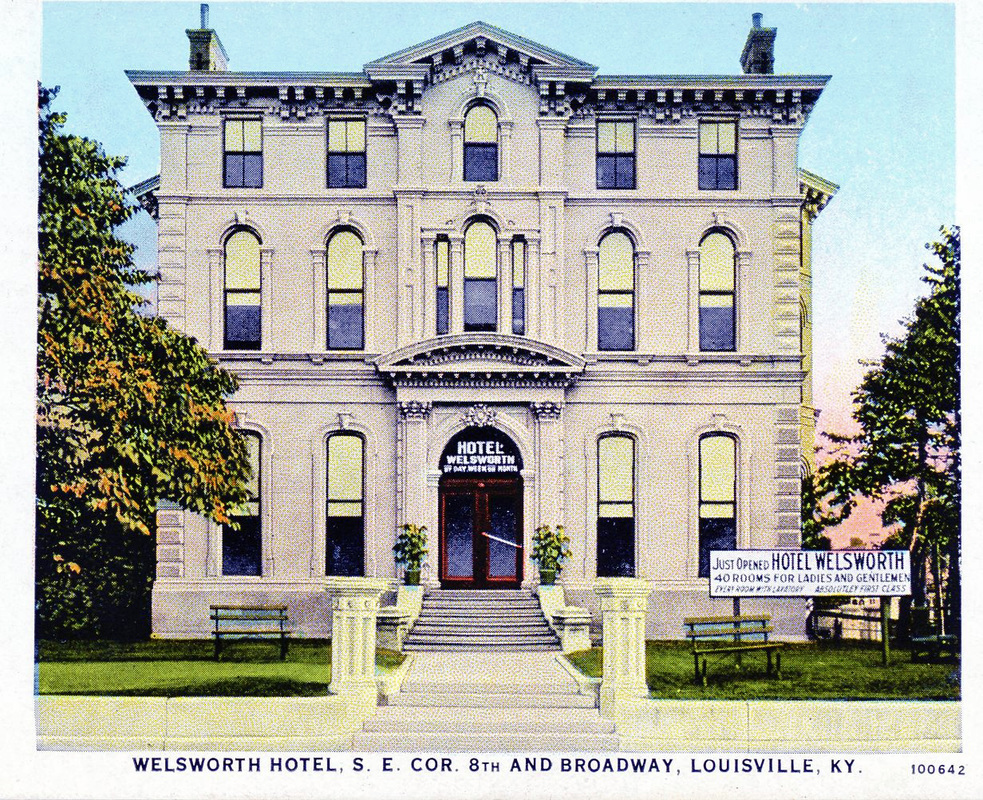
The Dulaney home on Broadway was so large, it was turned into a hotel in May, 1924. Prior to that it was used first by a religious order and then by the Louisville & Nashville Railroad for offices. The mansion was torn down in 1948 by F.W. Drybrough, who was described in the February 22, 1948 Courier-Journal as "an admitted speculator and opportunist" who tries to 'keep up with the times or be just a little ahead of the times.'"
Mr. Dulaney has made his home at the present family residence, 720 West Broadway, since 1872. Prior to that time for a number of years he occupied a smaller residence in the same block on Broadway. Before that he lived on Chestnut Street.
Mr. Dulaney has always been regarded as one of the wealthiest of Louisville men for many years. He leaves an estate, the value of which is estimated at being considerably in excess of $1,000,000. (Editor's note: the equivalent of $26.7 million today) Most of this property is in houses and lots. He owned about 160 acres of land near the end of Sixteenth Street, besides many houses, both residences and business blocks.
Member of St. Paul’s Church
Since shortly after his location in Louisville, Mr. Dulaney was a member of St. Paul’s Episcopal Church. He was for many years a regular attendant when the church was located at Sixth and Walnut streets, and continued his active membership after the removal of the church to Fourth Avenue and Victoria Place. He was a liberal giver to charity.
Given Woodford H. Dulaney's position on the board of managers for Cave Hill Cemetery, it’s not surprising that most of the family is buried there, in Section P, Lot E. His will included the following provision:
I devise to Cave Hill Investment company one thousand dollars ($1,000) the interest on which shall be used for the perpetual care of my lot in Cave Hill Cemetery.
Mr. Dulaney has always been regarded as one of the wealthiest of Louisville men for many years. He leaves an estate, the value of which is estimated at being considerably in excess of $1,000,000. (Editor's note: the equivalent of $26.7 million today) Most of this property is in houses and lots. He owned about 160 acres of land near the end of Sixteenth Street, besides many houses, both residences and business blocks.
Member of St. Paul’s Church
Since shortly after his location in Louisville, Mr. Dulaney was a member of St. Paul’s Episcopal Church. He was for many years a regular attendant when the church was located at Sixth and Walnut streets, and continued his active membership after the removal of the church to Fourth Avenue and Victoria Place. He was a liberal giver to charity.
Given Woodford H. Dulaney's position on the board of managers for Cave Hill Cemetery, it’s not surprising that most of the family is buried there, in Section P, Lot E. His will included the following provision:
I devise to Cave Hill Investment company one thousand dollars ($1,000) the interest on which shall be used for the perpetual care of my lot in Cave Hill Cemetery.
Florence Dulaney Willis and May Dulaney: The Last of the Dulaneys to Live at Tuliphurst
Late Pewee Valley Town Historian Gin Chadouin said that both May Dulaney and her widowed sister, Mrs. Florence Willis, were living at Tuliphurst during her childhood. Both women were friends with photographer Kate Matthews at Clovercroft. There are many pictures of Tuliphurst in the Kate Matthews Collection at the University of Louisville’s Ekstrom Library, including photos of the house itself, the gardens, the gate and the driveway. Florence was the last Dulaney to live in Tuliphurst. Her sister, May, preceded her in death by two years.
About May Dulaney
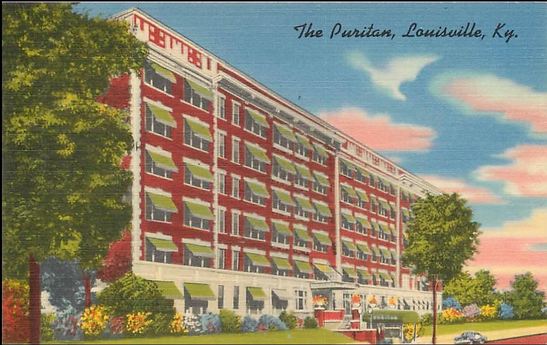 The Puritan Apartments are located at 1244 Fourth Avenue in Old Louisville
The Puritan Apartments are located at 1244 Fourth Avenue in Old Louisville
May Dulaney never married and was famed in Pewee Valley for her beautiful garden. She lived with her sister, Florence, most of her life. She died on July 10, 1942 in Louisville, at The Puritan, where she and Florence kept an apartment:
Miss May Dulaney, 76, died at 2:50 a.m. Thursday at her home in The Puritan. She had been ill two years. She was born in the residence built by her father, the late W.H. Dulaney, Sr., at 8th & Broadway, now the Welsworth Hotel. She had been active in St. James Episcopal Church for many years. Survivors are her sisters, Mrs. Albert S. Willis and Mrs. Judson C. Clements, Washington; nephews Woodford H. Dulaney and Albert S. Willis, and nieces Miss Claudine Clements, Miss Margaret Clements and Miss Mary Park Clements, all of Washington, and Mrs. Allen Harvey. Burial in Cave Hill Cemetery.
About Florence Dulaney Willis
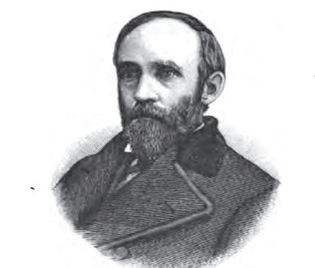 Albert S. Willis
Albert S. Willis
On November 20, 1878, Florence Dulaney married Shelbyville, Kentucky native, attorney and politician Albert S. Willis (1843-1897). His Congressional biography is below:
WILLIS, Albert Shelby, a Representative from Kentucky; born in Shelbyville, Shelby County, Ky., January 22, 1843; attended the common schools, and was graduated from the Louisville (Ky.) Male High School in 1860; taught school four years; was graduated from the Louisville Law School in 1866; was admitted to the bar and commenced the practice of law in Louisville; prosecuting attorney for Jefferson County 1874-1877; elected as a Democrat to the Forty-fifth and to the four succeeding Congresses (March 4, 1877-March 3, 1887); chairman, Committee on Rivers and Harbors (Forty-eighth and Forty-ninth Congresses); unsuccessful candidate for renomination in 1886; resumed the practice of law; appointed Minister to Hawaii by President Cleveland in 1893 and served until his death in Honolulu, Hawaii, January 6, 1897; interment in Cave Hill Cemetery, Louisville, Ky.
On the national scene, Willis’s greatest claim to national fame was his appointment as Minister to Hawaii shortly after the Hawaiian monarchy was overthrown and Queen Liliuokalani deposed: (from Wikipedia):
…Willis was sent to Hawaii on a secret mission to meet with Queen Liliuokalani and obtain a promise of amnesty for those involved in the overthrow of the monarchy if Cleveland restored her to the throne. Originally unsuccessful in securing such a promise in November 1893, when the queen changed her mind on December 18, 1893, Willis demanded on behalf of Cleveland to dissolve the Provisional Government of Hawaii. Willis’ mission was deemed a failure when Sandord B. Dole sent a written reply declining the surrender of his authority to the deposed queen. President Cleveland then referred the matter to Congress, which commissioned the Morgan Report, which exonerated the U.S. minister and peacekeepers from taking any part in the Hawaiian Revolution. Following the Morgan Report, Cleveland reversed his stance, rebuffed the queen's further pleas for interference, and maintained normal diplomatic relations with both the Provisional Government and the Republic of Hawaii.
More details of his historic role in Hawaii were included in this obituary, which ran in the January 16, 1897 edition of the New York Times:
MINISTER WILLIS IS DEAD
HE SUCCOMBS TO PNEUMONIA AT HONOLULU
The Hawiian Government Takes Suitable Action – The Body to be Sent to the United States – President Cleveland’s Sorrow
HONOLULU, Jan. 7, --United States Minister Albert S. Willis died yesterday morning at 8 o’clock, after several months’ illness.
The direct cause of his death was pneumonia, which he first contracted in San Francisco early last year. His condition had been at times such that it gave his family hope of his ultimate recovery, and again it was precarious to a degree that filled his physicians with alarm.
A few days ago his condition was much improved and his family renewed their hopes, but the change for the better was but temporary.
It is not known yet whether an escort will be sent to the United States with the remains, but it seems to be the opinion of a number of citizens that a representative of the Foreign Office should be detailed as an escort to accompany the remains to Louisville and turn them over to the officials there.
Until the funeral takes place a detail of gentlemen selected by the Minister of Foreign Affairs will remain at the Willis residence.
Directly the intelligence of the death of the Minister was received by the Government the flags on the Judiciary Building and Military Headquarters were lowered to half mast. Most of the business houses and the shipping followed the example.
Mrs. Willis in nearly prostrated from the long care of her husband. The family expects to sail for home with the remains on the steamer Australia on the 13th.
The Hawaiian Government will accord a State funeral to the deceased representative of the United States tomorrow. The body will lie in state during the morning, in the former throne room. Funeral services will be held at 8 P.M. in the Central Union Church. The procession to the cemetery, where the body will be placed in the receiving vault until the sailing of the steamer, will be proceeded by the local military and a battalion from the United States Steamship Alert. President Dole and the chief officials of the Government will follow the mourners. It will be the most imposing funeral since the burial of King Kalakaua.
Mr. Willis left a small estate, but ample life insurance.
SKETCH OF MR. WILLIS’ CAREER
His Duties in Hawaii as Representative of the United States
Albert S. Willis was born in Shelby County, Ky. in 1843. He received his early education in the common schools of his county and in the Louisville Male High School. He was graduated from the Louisville Law School in 1866.
After his graduation he devoted himself to the practice of his profession. In 1877 he was elected as Representative in the Forty-fifth Congress. He was re-elected to the Forty-sixth, Forty-seventh, Forth-eighth and Forty-ninth Congresses.
In 1893 he was appointed by President Cleveland as Envoy Extraordinary and Minister Plenipotentiary to Hawaii. The appointment was made soon after the return of Commissioner James H. Blount, who had been sent to Honolulu by the President to investigate the facts of the revolution against Queen Liliuokalani. Mr. Willis reached Honolulu early in November 1883. It was approved in Honolulu that his mission was to restore the monarchy, and his arrival created great excitement. His instructions, however, were of a different sort. The scope of his mission appeared in his account of an interview with Liliuokalani, which was as follows:
“I made known to her the President’s sincere regret that, through the unauthorized intervention of the United States, she had been obliged to surrender her sovereignty, and his hope that, with her consent and cooperation, the wrong done to her and to her people might be redressed. To this she bowed her acknowledgments.
“I said to her, “The President expects and believes that when re-instated, you will show forgiveness and magnanimity; that you will wish to be Queen of all the people, both native and foreign born; that you will make haste to secure their love and loyalty, and to establish peace, friendship and good government.’
“To this she made no reply.
“After waiting for a moment, I continued: ‘The President not only tenders you sympathy, but wishes to help you. Before fully making known to you his purposes, I desire to know whether you are willing to answer certain questions which it is my duty to ask?’
“She answered, ‘I am willing.’
“I then asked her: ‘Should you be restored to the throne, would you grant full amnesty as to life and property as to all those persons who have been or who are now in the Provisional Government, or who have been instrumental in the overthrow of your Government?”
“She hesitated a moment, and then slowly and calmly answered: ‘There are certain laws of my Government by which I will abide. My decision would be, as the law directs, that such persons would be beheaded, and their property confiscated to the Government.’
“I then said, repeating very distinctly her words: ‘It is your opinion that these people should be beheaded and their property confiscated?’
“She replied: ‘It is.’
“I then said to her: ‘Do you fully understand the meaning of every word which I have said to you, and of every word which you have said to me, and if so, do you still have the same opinion?’
“Her answer was: ‘I have understood and mean all I have said, but I might leave the decision of this to my Ministers.’
“To this I replied: ‘Suppose it were necessary to make a decision before you appointed any Ministers, and that you were asked to issue a royal proclamation of general amnesty, would you do it?”
“She answered: ‘I have no legal right to do that, and I would not do it.’
“Pausing a moment, she continued: ‘These people were the cause of the revolution and Constitution of 1887. There will never be any peace while they are here. They must be sent out of the country, or punished, and their property confiscated.’
“I then said: ‘I have no further communication to make to you now, and will have none until I hear from my Government, which will probably be three or four weeks.’
While awaiting further instructions from Washington, Minister Willis was practically without a Government to present himself. Dec. 19, 1893, Minister Willis presented a communication to the Provisional Government, of which Mr. Dole was president, suggesting restoration to Queen Liliuokalani of her constitutional authority. President Dole refused, whereupon the United States Minister, finding himself without authority or power to enforce his demands, asked President Dole’s permission to withdraw the letter. This was also refused by the Provisional President and the Minister was then instructed to keep the United States advised of conditions on the island.
The Republic of Hawaii was proclaimed July 4, 1894, and Minister Willis wrote to Francis W. Hatch, Minister of Foreign Affairs under President Dole, recognizing for the President of the United States the new Government at Honolulu.
Since this period, the relations between Hawaii and the United States have been uninterrupted and Minister Willis continued to represent this Government at Honolulu up to the time of his fatal illness.
MINISTER WILLIS IS DEAD
HE SUCCOMBS TO PNEUMONIA AT HONOLULU
The Hawiian Government Takes Suitable Action – The Body to be Sent to the United States – President Cleveland’s Sorrow
HONOLULU, Jan. 7, --United States Minister Albert S. Willis died yesterday morning at 8 o’clock, after several months’ illness.
The direct cause of his death was pneumonia, which he first contracted in San Francisco early last year. His condition had been at times such that it gave his family hope of his ultimate recovery, and again it was precarious to a degree that filled his physicians with alarm.
A few days ago his condition was much improved and his family renewed their hopes, but the change for the better was but temporary.
It is not known yet whether an escort will be sent to the United States with the remains, but it seems to be the opinion of a number of citizens that a representative of the Foreign Office should be detailed as an escort to accompany the remains to Louisville and turn them over to the officials there.
Until the funeral takes place a detail of gentlemen selected by the Minister of Foreign Affairs will remain at the Willis residence.
Directly the intelligence of the death of the Minister was received by the Government the flags on the Judiciary Building and Military Headquarters were lowered to half mast. Most of the business houses and the shipping followed the example.
Mrs. Willis in nearly prostrated from the long care of her husband. The family expects to sail for home with the remains on the steamer Australia on the 13th.
The Hawaiian Government will accord a State funeral to the deceased representative of the United States tomorrow. The body will lie in state during the morning, in the former throne room. Funeral services will be held at 8 P.M. in the Central Union Church. The procession to the cemetery, where the body will be placed in the receiving vault until the sailing of the steamer, will be proceeded by the local military and a battalion from the United States Steamship Alert. President Dole and the chief officials of the Government will follow the mourners. It will be the most imposing funeral since the burial of King Kalakaua.
Mr. Willis left a small estate, but ample life insurance.
SKETCH OF MR. WILLIS’ CAREER
His Duties in Hawaii as Representative of the United States
Albert S. Willis was born in Shelby County, Ky. in 1843. He received his early education in the common schools of his county and in the Louisville Male High School. He was graduated from the Louisville Law School in 1866.
After his graduation he devoted himself to the practice of his profession. In 1877 he was elected as Representative in the Forty-fifth Congress. He was re-elected to the Forty-sixth, Forty-seventh, Forth-eighth and Forty-ninth Congresses.
In 1893 he was appointed by President Cleveland as Envoy Extraordinary and Minister Plenipotentiary to Hawaii. The appointment was made soon after the return of Commissioner James H. Blount, who had been sent to Honolulu by the President to investigate the facts of the revolution against Queen Liliuokalani. Mr. Willis reached Honolulu early in November 1883. It was approved in Honolulu that his mission was to restore the monarchy, and his arrival created great excitement. His instructions, however, were of a different sort. The scope of his mission appeared in his account of an interview with Liliuokalani, which was as follows:
“I made known to her the President’s sincere regret that, through the unauthorized intervention of the United States, she had been obliged to surrender her sovereignty, and his hope that, with her consent and cooperation, the wrong done to her and to her people might be redressed. To this she bowed her acknowledgments.
“I said to her, “The President expects and believes that when re-instated, you will show forgiveness and magnanimity; that you will wish to be Queen of all the people, both native and foreign born; that you will make haste to secure their love and loyalty, and to establish peace, friendship and good government.’
“To this she made no reply.
“After waiting for a moment, I continued: ‘The President not only tenders you sympathy, but wishes to help you. Before fully making known to you his purposes, I desire to know whether you are willing to answer certain questions which it is my duty to ask?’
“She answered, ‘I am willing.’
“I then asked her: ‘Should you be restored to the throne, would you grant full amnesty as to life and property as to all those persons who have been or who are now in the Provisional Government, or who have been instrumental in the overthrow of your Government?”
“She hesitated a moment, and then slowly and calmly answered: ‘There are certain laws of my Government by which I will abide. My decision would be, as the law directs, that such persons would be beheaded, and their property confiscated to the Government.’
“I then said, repeating very distinctly her words: ‘It is your opinion that these people should be beheaded and their property confiscated?’
“She replied: ‘It is.’
“I then said to her: ‘Do you fully understand the meaning of every word which I have said to you, and of every word which you have said to me, and if so, do you still have the same opinion?’
“Her answer was: ‘I have understood and mean all I have said, but I might leave the decision of this to my Ministers.’
“To this I replied: ‘Suppose it were necessary to make a decision before you appointed any Ministers, and that you were asked to issue a royal proclamation of general amnesty, would you do it?”
“She answered: ‘I have no legal right to do that, and I would not do it.’
“Pausing a moment, she continued: ‘These people were the cause of the revolution and Constitution of 1887. There will never be any peace while they are here. They must be sent out of the country, or punished, and their property confiscated.’
“I then said: ‘I have no further communication to make to you now, and will have none until I hear from my Government, which will probably be three or four weeks.’
While awaiting further instructions from Washington, Minister Willis was practically without a Government to present himself. Dec. 19, 1893, Minister Willis presented a communication to the Provisional Government, of which Mr. Dole was president, suggesting restoration to Queen Liliuokalani of her constitutional authority. President Dole refused, whereupon the United States Minister, finding himself without authority or power to enforce his demands, asked President Dole’s permission to withdraw the letter. This was also refused by the Provisional President and the Minister was then instructed to keep the United States advised of conditions on the island.
The Republic of Hawaii was proclaimed July 4, 1894, and Minister Willis wrote to Francis W. Hatch, Minister of Foreign Affairs under President Dole, recognizing for the President of the United States the new Government at Honolulu.
Since this period, the relations between Hawaii and the United States have been uninterrupted and Minister Willis continued to represent this Government at Honolulu up to the time of his fatal illness.
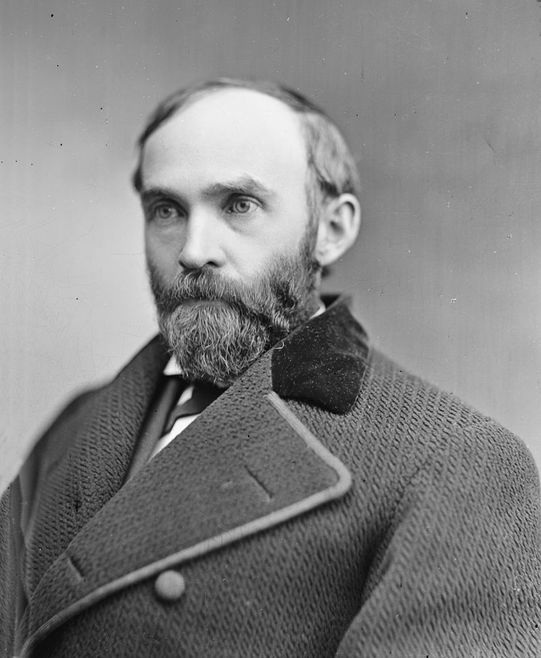 Kentucky Congressman Albert S. Willis
Kentucky Congressman Albert S. Willis
The Courier-Journal also carried a lengthy obituary, but their reporting focused more on the circumstances of his death, and on his life and accomplishments in his native state of Kentucky:
DETAILS
___________
Of the Death of the Hon.
Albert S. Willis
______________________
AT HIS POST OF DUTY
___________________________
NEVER RECOVERED FROM COLD
CONTRACTED AT HOME....
... In April last, the Minister and family left for a visit to their old home at Louisville. While in San Francisco on the return trip, the minister contracted a severe cold, which settled upon his lungs. This was the immediate cause of death. At noon on Oct. 30, while leaving church, his horse ran away and threw Mr. Willis to the ground. He was taken to a physician's office and soon recovered sufficiently to return to his home at Waikiki. He never left it again.
Fever increased and the cold taken in San Francisco soon developed into pneumonia. This settled so firmly upon the lungs that it could not be checked. Three physicians labored incessantly and held frequent conferences on the case. A few days before Christmas the case was pronounced hopeless.
Soon after the death of the minister all the Consular Government and shipping flags were lowered to half-mast...
... At the request of Mrs. Willis, the funeral services took place at the Central Union Church at 3 p.m. on January 7 ... The funeral procession was the most impressive since Kalakaua...
MR. WILLIS' SUCCESSFUL CAREER
_________________________________________
By Dint of Ability and Energy He
Rose to High Position
Albert Shelby Willis, born in Shelby county, January 22, 1843, was one of three children of Dr. Shelby Willis, a prominent physician of Shelby county, who died in 1846, leaving a daughter Ianthe, lately deceased, and two sons, Albert and John, the latter now a resident of this city. Dr. Willis' wife also survived him, and came to this city in 1850, where in 1852, she married Hon. J.L. Clemmons, then and now one of the prominent members of the Louisville bar....Mr. Willis ... entered the public schools ... and was graduated at the early age of 16. After graduating, he taught school for two years in Jefferson county, where many of his pupils were his seniors by several years, and devoted his spare time to reading elementary law. He then attended the Louisville Law School for two years and graduated at twenty years, too young by a year to be admitted to the practice at the bar. To fill in this interim he returned to teaching ... until he was old enough to be licensed to practice. He at once formed a partnership with his stepfather, Mr. Clemmons, a partnership that continued with some intermissions and rearrangements until he left for Hawaii. in 1893...
DETAILS
___________
Of the Death of the Hon.
Albert S. Willis
______________________
AT HIS POST OF DUTY
___________________________
NEVER RECOVERED FROM COLD
CONTRACTED AT HOME....
... In April last, the Minister and family left for a visit to their old home at Louisville. While in San Francisco on the return trip, the minister contracted a severe cold, which settled upon his lungs. This was the immediate cause of death. At noon on Oct. 30, while leaving church, his horse ran away and threw Mr. Willis to the ground. He was taken to a physician's office and soon recovered sufficiently to return to his home at Waikiki. He never left it again.
Fever increased and the cold taken in San Francisco soon developed into pneumonia. This settled so firmly upon the lungs that it could not be checked. Three physicians labored incessantly and held frequent conferences on the case. A few days before Christmas the case was pronounced hopeless.
Soon after the death of the minister all the Consular Government and shipping flags were lowered to half-mast...
... At the request of Mrs. Willis, the funeral services took place at the Central Union Church at 3 p.m. on January 7 ... The funeral procession was the most impressive since Kalakaua...
MR. WILLIS' SUCCESSFUL CAREER
_________________________________________
By Dint of Ability and Energy He
Rose to High Position
Albert Shelby Willis, born in Shelby county, January 22, 1843, was one of three children of Dr. Shelby Willis, a prominent physician of Shelby county, who died in 1846, leaving a daughter Ianthe, lately deceased, and two sons, Albert and John, the latter now a resident of this city. Dr. Willis' wife also survived him, and came to this city in 1850, where in 1852, she married Hon. J.L. Clemmons, then and now one of the prominent members of the Louisville bar....Mr. Willis ... entered the public schools ... and was graduated at the early age of 16. After graduating, he taught school for two years in Jefferson county, where many of his pupils were his seniors by several years, and devoted his spare time to reading elementary law. He then attended the Louisville Law School for two years and graduated at twenty years, too young by a year to be admitted to the practice at the bar. To fill in this interim he returned to teaching ... until he was old enough to be licensed to practice. He at once formed a partnership with his stepfather, Mr. Clemmons, a partnership that continued with some intermissions and rearrangements until he left for Hawaii. in 1893...
|
Congressman Albert Willis' Legacy Lives on in Louisville
|
... Mr. Willis' first political preferment was in 1872, when he was the Democratic elector for this district. As such he canvassed the district and part of the State, but at the request of the Indiana Committee, spent a large share of his time in "stumping" Indiana, then, as now, a doubtful State.
Shortly after this he was elected County Attorney ... It was while he was County Attorney that the confidence in him by those who best knew him was strikingly shown. The county came into possession of about $40,000 of "bounty money," and the County Magistrates who had control of it insisted on his taking absolute charge of its care and disbursement... On November 20, 1878, he married Miss Florence Dulaney, daughter of Mr. W.H. Dulaney ... Mrs. Willis and one son, Albert S., Jr., sixteen years old, were with Mr. Willis at his death, as was Miss May Dulaney, his sister (editor's note: she was his sister-in-law). Upon the refusal of Henry Watterson ... to stand for reelection, Mr. Willis was elected to Congress for the term commencing in December, 1877. He served as Congressman five terms or ten years ... until ... 1887 ... It is said that 1,500 deserving and distressed pensioners ... owe to his efforts the payment of their claims. It was due to him that the Louisville and Portland canal was made a free canal by the United States Government, saving thousands of dollars to the river men of the Ohio and its tributaries. He had the life-saving station established ... and by his efforts were started the "blowing out" and improvement of the channel of the river ... ... Mr. Willis was able to have established in this city the American Printing House for the Blind, and to have appropriated for its benefit $250,000. This is the only charity of its kind in the United States ... ... Almost entirely owing to his energy, influence with his fellow members and skill in congressional tactics ... is the building of the new Custom-house and post office for the city of Louisville, ... costing more than $1,000,000 ... ... Leaving Congress in 1887, poorer than when he entered in 1877, Mr Willis engaged in legal business, representing in one case the City of Louisville, in which she recovered more than $50,000 of old and seemingly impossible claims against the United States Government. He was also chief in founding, and for some time was president of, the Sun Life Insurance Company, now a successful and flourishing industrial insurance company... After her husband’s death, Florence returned to Louisville with her only child, Albert, and sister, May. She buried her husband in Cave Hill Cemetery and lived at her parents' palatial home on Broadway. Her mother died in 1901 and her father the next year. The December 17, 1902 Courier-Journal reported: ... the entire estate is left in trust to his children -- Mrs. Willis, Mrs. Lizzie Dulaney Clements, Miss May Dulaney, Woodford Hector |
|
Dulaney, Jr., and his grandson, Woodford J. Dulaney, son of Robert Lee Dulaney, a deceased son of the testator. All of the immediate heirs are to receive a life interest with the property to finally be divided out to their descendants...
Florence and her brother-in-law, Judson C. Clements, were named executors. Florence also inherited all the property owned by her unmarried aunt, Elizabeth Ann Dulaney, in 1906. Once their parents' estates were settled, Florence and May traveled extensively, visiting Naples, Italy in 1904 and Constantinople in 1906. By May 1911, they were using Tuliphurst as their primary residence, although they continued to travel. At some point around 1922, they began wintering on Sanibel Island at a seaside cottage Florence purchased and named "Endora." Florence may have become interested in Sanibel through friend and neighbor, Kate Matthews. Kate's brother, William, and sister-in-law, Harriet, had owned The Matthews resort (now the Island Inn) on Sanibel since 1895. There is a 1930s-era photo of Florence and Kate standing in front of Miss Charlotta's Tea Room, operated by Kate's niece, at the Sanibel Library. On March 2, 1931, Florence's son, Albert, married Isabelle Isert at Ft. Meyers, Fla. The announcement of their wedding in the Ft. Meyers News-Press identified Albert as "of Louisville, Ky., and Sanibel Island." Kate's niece, Miss Charlotte Matthews, was part of the wedding party. Florence Dulaney Willis died on June 5, 1944. Her will, completed less than a month before her death, is on file at the Oldham County Courthouse. Thanks to Oldham County Clerk Julie Barr for making a copy of it available to the Pewee Valley Historical Society: , Florence Dulaney Willis, widow, a resident of Pewee Valley, Oldham County, Kentucky, on this 17 day of May, 1944, make this my last Will, and hereby revoke all former Wills and Codicils that I may have made. Item I. I direct that my just and legal debts, funeral expenses and the cost of administering my estate be first paid. I direct that all inheritance taxes and Federal estate taxes that may be assessed against my estate, or against any bequest or devise herein made, be paid by my Executor out of my estate generally, as though such taxes were a debt against my estate. Item 2. All household and personal effects of which I may die possessed, including all jewelry and any automobile, I bequeath to my son Albert Shelby Willis. Item 3. I bequeath to my said son, Albert Shelby Willis, absolutely and in fee simple, the sum of One Thousand dollars ($1,000) Item 4. I have purchased the interest of my son, Albert S. Willis, in the estate of my father, Woodford H. Dulaney, in the Jefferson Circuit Court, and now own that interest. If I should own that interest at my death, I wish it to pass under the terms of the Will of my father, Woodford H. Dulaney, and not to pass under this Will of mine. |
|
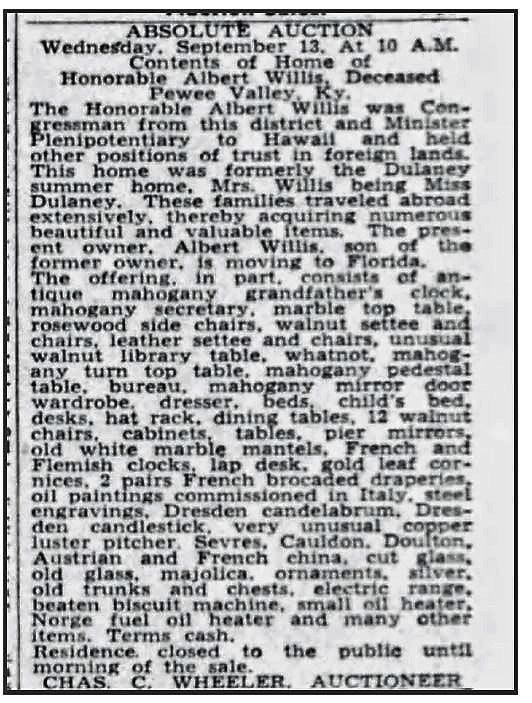 Courier-Journal September 10, 1944 Courier-Journal September 10, 1944
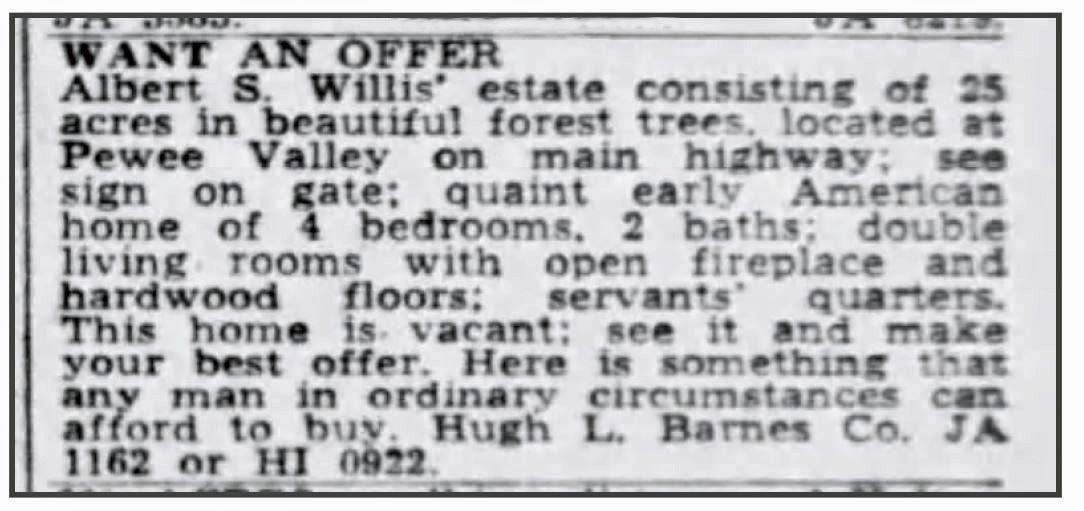 Courier-Journal November 1, 1944 Courier-Journal November 1, 1944
|
Item 5. I now own a house, on a lot of about six acres, at Sanibel Island, Lee County, Florida. If I should own that property at my death I devise it in fee simple to my son Albert Shelby Willis.
Item 6. I now own the following described lots in Louisville, Jefferson County, Ky. If I should own said lots at my death, I devise them in fee simple to my son, Albert Shelby Willis: (a) Lot 52-1/2 x 165 N Quarry, Stoll & Sturgess, Lott 18, Blo (b) Lot 172-1/2 x Creek N Quarry, Charlton & Sturgess, Lot 4, Block 1184ck 1185 (c) Lot 30x165 N Quarry, Stoll & Sturgess, Lot 15, Block 1185 Florence left the remainder of her estate in trust for her son, who was to receive the net income from it during his lifetime. Though Tuliphurst was never mentioned specifically in her will, Albert, Jr., wasted very little time in selling both the contents and the property itself and hightailing it to Florida. The contents were auctioned on September 13, 1944 and the home was on the market by the first of November Florence left the remainder of her estate in trust for her son, who was to receive the net income from it during his lifetime. Though Tuliphurst was never mentioned specifically in her will, Albert, Jr., wasted very little time in selling both the contents and the property itself and hightailing it to Florida. The contents were auctioned on September 13, 1944 and the home was on the market by the first of November. Two other members of the extended Dulaney family lived in Pewee Valley for a time. One was Dr. Gavin Fulton, the brother of Caroline Fulton, who married Woodford Dulaney’s son and namesake, W. Hector Dulaney (ca. 1859-May 20, 1903). The other was Mrs. Anna McAfee Dulaney, who was married for just a year to Woodford Dulaney's son, Robert Lee. |
1955: The Pearsons Buy Tuliphurst and Subdivide the Property
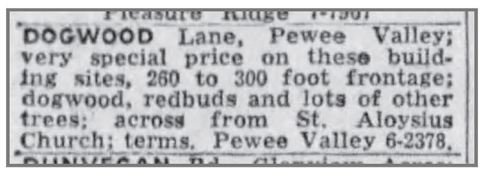 April 28, 1957 classified ad for lots on Dogwood Lane
April 28, 1957 classified ad for lots on Dogwood Lane
Tuliphurt Manor Subdivision -- more commonly known today as Dogwood Lane-- is one of Pewee Valley's earliest subdivisions. It was developed in 1955 by builder J. Guy Pearson. Pearson removed the estate's original gate and created Dogwood Lane out of a portion of the original drive. Despite what residents may believe today, Dogwood Lane was designed to run straight through from Hwy. 146 to Old Forest Road, according to the original subdivision plat.
While building the subdivision, Guy and his wife, Zella, also restored Tuliphurst, which had fallen into serious disrepair in the years following Florence Dulaney Willis' death. Bringing the house back from the brink after a decade of neglect and abuse took under a year, according to Janet Lowell Walker, who wrote a story about the renovation called, "A House Brought Back to Life," for the May 12, 1957 Courier-Journal & Times Sunday Magazine. The house was originally built on stone pillars and needed jacking up and a new foundation. Roofing, insulation, termite prevention and a new heating system were part of the project. On the interior, the Pearsons added a new screened porch and upstairs and downstairs baths, carved a modern kitchen out of a former hall and storage area, added closets all over the house -- it previously had none -- and painted and papered.
Zella Pearson told the story of how the Pearsons acquired the property and funded the house renovation in the May 25, 1958 Courier-Journal, which announced their sale of Tuliphurst to the Boldts:
... "I went around and tried to buy it for $17,000 and found it had already been sold. Then I went to the man who bought it and told him I wanted it. It was really desolate looking -- I'd looked at it on a cold winter day with snow on the ground.
She wanted it so badly, she gladly paid the new buyer's asking price of $25,000 -- thus giving him a profit of $7,000 for his short term investment.
Since then the Pearsons have spent about $20,000 improving the place. And they subdivided a portion of the 23 acre estate, calling the subdivision Tuliphurst Manor. Five lots have been sold for $3,000-$4,000 each, and two new homes are now finished. The Pearsons still have eight lots left. They sold about five acres with the house.
At the moment, they've "about come out even" on their original investment, and anticipate the remaining lots will sell readily ...
Interior Shots of Tuliphurst from the April 1974 Call of the Pewee
The Boldts: 1958-197?
Col. Stephen Chase Boldt, and his wife, Eleanor, paid the Pearsons $30,500 for Tuliphurst. They were looking for a place to live following Col. Boldt's retirement from the military,
S.C. Boldt's 38-year military career had taken him away from his Louisville home town for many years. Boldt was just a teenager when he joined the service less than a month after the U.S. entered WWI. He and his friend, Claude Watkins, quit Male High School and enlisted in the 1st Kentucky Infantry on May 3, 1917. At the time, Boldt was four days shy of his seventeenth birthday.
Battery F, 138th Field Artillery, was organized in October, 1917, when the 1st Infantry was converted to the 138th Field Artillery. The battery was composed of the enlisted personnel of Companies G and H, and the Machine Gun Company of the old 1st Infantry Regiment. Its first commanding officer was Capt. George M. Chescheir, who formerly commanded the Machine Gun Company of the 1st Kentucky Infantry (1938). Claude Watkins was the commanding officer of the unit's 1st Battalion and Capt. Stephen C. Boldt was commanding officer of Battery F. Though the 138th Field Artillery was shipped overseas in WWI, the unit never saw any action.
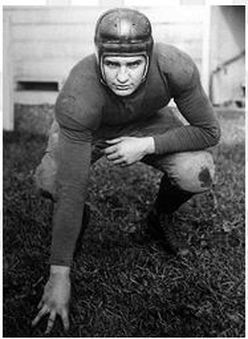 Stephen "Chase" Boldt playing for the Louisville Brecks
Stephen "Chase" Boldt playing for the Louisville Brecks
After returning to Louisville, "Chase" Boldt had a short-lived pro football career. From 1921 to 1923, he played for the Louisville Breckenridges, better known as the Louisville Brecks. At 5'7" and 145 pounds, he probably wouldn't have a shot at a pro career today. But professional football was a very different sport when it was first getting organized, as Dave Rose observed in an April 2012 story written for Louisville.com:
In the early days of American football the men who played it didn’t make millions of dollars. More often than not they all had day jobs- and these were professionals. The athletes of the National Football League, back when football was just a past time born out of Canton, Ohio, would be shocked to see the revenue generated from the gridiron today. Even in the “Superbowl Era” it’s been said that most of the athletes on Vince Lombardi’s Packers teams, actually worked separate jobs outside of the pigskin.
Boldt rejoined his old army unit, the 138th Field Artillery, when it was reorganized in 1921. He rose through the ranks, and in 1939, was promoted to lieutenant colonel. In civilian life, he was a manager for the Louisville office of C.G. Conn, Ltd., an Elkhart, Indiana-based musical instrument manufacturer.
In the early days of American football the men who played it didn’t make millions of dollars. More often than not they all had day jobs- and these were professionals. The athletes of the National Football League, back when football was just a past time born out of Canton, Ohio, would be shocked to see the revenue generated from the gridiron today. Even in the “Superbowl Era” it’s been said that most of the athletes on Vince Lombardi’s Packers teams, actually worked separate jobs outside of the pigskin.
Boldt rejoined his old army unit, the 138th Field Artillery, when it was reorganized in 1921. He rose through the ranks, and in 1939, was promoted to lieutenant colonel. In civilian life, he was a manager for the Louisville office of C.G. Conn, Ltd., an Elkhart, Indiana-based musical instrument manufacturer.
Alan Levy reported on the Boldts' move to Pewee Valley in the August 3, 1958 Courier-Journal. His story focused on Col. Boldt's military service during and after WWII:
Veteran of 38 Years' Army Service
Retires to Historic Tuliphurst
"Pardon me, sir, but since when does the sun rise in the west?"
Because Col. Stephen Chase Boldt couldn't answer that question, some 150 Kentuckians and several hundred other servicemen aboard the Army transport Johnson -- in the Pacific Ocean on December 8, 1941 -- learned that they were at war.
Colonel Boldt, 56, returned here yesterday after retiring from the Army. He is a veteran of 38 years' service -- including 27 years on active duty. In retirement, he will be permanently stationed at Tuliphurst, a historic old Pewee Valley house that he purchased in May.
He recalled the confusion that surrounded his entry into the war.
"I was commanding a Kentucky National Guard unit -- the second battalion of the 138th Field Artillery. We went on active duty January 17, 1941, at Camp Shelby in Louisiana. In October, we were on maneuvers in Louisiana.
"The division commander called me in and said, 'This is most peculiar. You are relieved of your assignment to the 38th Infantry Division and will report to base camp. That's all I know.'"
At Camp Shelby, Boldt learned that his unit was going overseas. The orders were top secret. The 325 men in the Kentucky unit (only 150 were Kentuckians; the rest were transfers and draftees) reached the San Francisco Port of Embarkation December 3.
They and other soldiers and Army Air Corps then boarded the Johnson and sailed immediately on Dec. 4. 12 hours after sailing, Boldt -- who was still in command of the men -- and the ship's master met in wardroom to open their sealed orders.
"The orders said we were to pick up our naval escort southwest of Guam and proceed from there to Manila in the Philippines," Boldt said.
"On Dec. 7, the master called me to the bridge. He had a glint in his eye, but all he said was, 'I've got a message for you.'
"The message was, 'JAPANESE RAID THIS MORNING PEARL HARBOR. THIS IS NO DRILL.'"
"We were 700 miles from Pearl Harbor, but we just kept on sailing and didn't say anything to the men. We'd taken up all radio sets before sailing, so nobody found out anything for awhile.
"Four hours later we get a message to blackout the ship and go back to San Francisco. We turned around, but we didn't let anyone know what was happening.
"The next morning, though, an Army Air Corps captain turned to me and on bridge and asked, "Why are we turned around, sir?"
"I said, 'Who says we're turned around,' and that was when he asked me what the sun was doing in the west.
"The word spread in a matter of minutes, so I called an officer's meeting and announced that a state of war existed."
The Johnson reached San Francisco several nights later at 9 p.m. and was unloaded at 20:30 p.m. But security would not allow the men to call their relatives in Kentucky, where newspaper offices and radio stations had been swamped by worried callers.
Actually, Boldt's men knew less about the situation than people in Kentucky.
At 11 p.m., the men boarded the Matsonia, another ship, and were headed for Pearl Harbor, which was still burning when they arrived.
Subsequent assignments took him to England, Norway and Korea...
Veteran of 38 Years' Army Service
Retires to Historic Tuliphurst
"Pardon me, sir, but since when does the sun rise in the west?"
Because Col. Stephen Chase Boldt couldn't answer that question, some 150 Kentuckians and several hundred other servicemen aboard the Army transport Johnson -- in the Pacific Ocean on December 8, 1941 -- learned that they were at war.
Colonel Boldt, 56, returned here yesterday after retiring from the Army. He is a veteran of 38 years' service -- including 27 years on active duty. In retirement, he will be permanently stationed at Tuliphurst, a historic old Pewee Valley house that he purchased in May.
He recalled the confusion that surrounded his entry into the war.
"I was commanding a Kentucky National Guard unit -- the second battalion of the 138th Field Artillery. We went on active duty January 17, 1941, at Camp Shelby in Louisiana. In October, we were on maneuvers in Louisiana.
"The division commander called me in and said, 'This is most peculiar. You are relieved of your assignment to the 38th Infantry Division and will report to base camp. That's all I know.'"
At Camp Shelby, Boldt learned that his unit was going overseas. The orders were top secret. The 325 men in the Kentucky unit (only 150 were Kentuckians; the rest were transfers and draftees) reached the San Francisco Port of Embarkation December 3.
They and other soldiers and Army Air Corps then boarded the Johnson and sailed immediately on Dec. 4. 12 hours after sailing, Boldt -- who was still in command of the men -- and the ship's master met in wardroom to open their sealed orders.
"The orders said we were to pick up our naval escort southwest of Guam and proceed from there to Manila in the Philippines," Boldt said.
"On Dec. 7, the master called me to the bridge. He had a glint in his eye, but all he said was, 'I've got a message for you.'
"The message was, 'JAPANESE RAID THIS MORNING PEARL HARBOR. THIS IS NO DRILL.'"
"We were 700 miles from Pearl Harbor, but we just kept on sailing and didn't say anything to the men. We'd taken up all radio sets before sailing, so nobody found out anything for awhile.
"Four hours later we get a message to blackout the ship and go back to San Francisco. We turned around, but we didn't let anyone know what was happening.
"The next morning, though, an Army Air Corps captain turned to me and on bridge and asked, "Why are we turned around, sir?"
"I said, 'Who says we're turned around,' and that was when he asked me what the sun was doing in the west.
"The word spread in a matter of minutes, so I called an officer's meeting and announced that a state of war existed."
The Johnson reached San Francisco several nights later at 9 p.m. and was unloaded at 20:30 p.m. But security would not allow the men to call their relatives in Kentucky, where newspaper offices and radio stations had been swamped by worried callers.
Actually, Boldt's men knew less about the situation than people in Kentucky.
At 11 p.m., the men boarded the Matsonia, another ship, and were headed for Pearl Harbor, which was still burning when they arrived.
Subsequent assignments took him to England, Norway and Korea...
Why did the Boldts choose Pewee Valley for their retirement? For one thing, they had family here. Eleanor Boldt's sister, Leta, and brother-in-law, Ivo Howard, were living in Powhatan Wooldridge's former hunting lodge on Wooldridge Avenue.
For the other, Eleanor loved old homes and felt strongly about the importance of preserving the past. In 1974, she wrote a letter to the editor of the Courier-Journal, decrying the Louisville Woman's Club plan to "pave paradise and put up a parking lot:"
May 21, 1974 Courier-Journal -- Would Preserve Homes
Although I am a native of Kentucky, during the years my husband was in the army, we lived in various states and I had great admiration for those who took pride in the preservation of the architecture of the past. I think the state of Virginia perhaps ranks first "in caring."
On my husband's retirement in 1958 and on our return to Kentucky to live, I was appalled to see the many old homes that had been destroyed for the sake of progress. Although there seem to be a few citizens in Louisville who care about the preservation of the beauty of our city, a majority seem to ignore the damage that is being done, as witness the attempt of The Louisville Woman's Club to demolish the two lovely homes adjacent to their property.
Though Mayor Sloan has had meters installed where one can park for a nominal sum for three hours, their crusade "marches on." Please let us not be known as the city the citizens destroyed.
For the other, Eleanor loved old homes and felt strongly about the importance of preserving the past. In 1974, she wrote a letter to the editor of the Courier-Journal, decrying the Louisville Woman's Club plan to "pave paradise and put up a parking lot:"
May 21, 1974 Courier-Journal -- Would Preserve Homes
Although I am a native of Kentucky, during the years my husband was in the army, we lived in various states and I had great admiration for those who took pride in the preservation of the architecture of the past. I think the state of Virginia perhaps ranks first "in caring."
On my husband's retirement in 1958 and on our return to Kentucky to live, I was appalled to see the many old homes that had been destroyed for the sake of progress. Although there seem to be a few citizens in Louisville who care about the preservation of the beauty of our city, a majority seem to ignore the damage that is being done, as witness the attempt of The Louisville Woman's Club to demolish the two lovely homes adjacent to their property.
Though Mayor Sloan has had meters installed where one can park for a nominal sum for three hours, their crusade "marches on." Please let us not be known as the city the citizens destroyed.
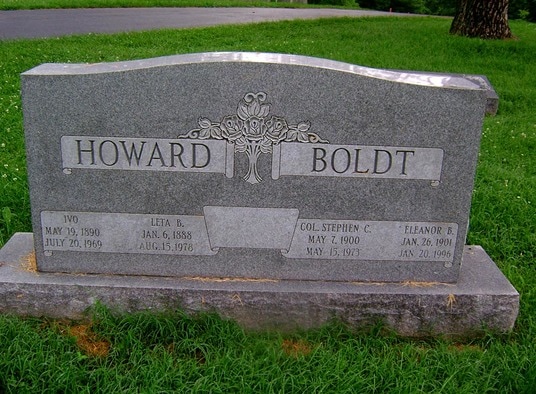 Colonel Stephen Chase Boldt and his wife, Eleanor, are buried in Floydsburg Cemetery. They share a headstone with Eleanor's sister, Leta, and brother in law, Ivo Howard.
Colonel Stephen Chase Boldt and his wife, Eleanor, are buried in Floydsburg Cemetery. They share a headstone with Eleanor's sister, Leta, and brother in law, Ivo Howard.
On May 15, 1973, Col. Boldt passed away at the old Kentucky Baptist Hospital on Barrett Avenue and was buried at Floydsburg Cemetery. His obituary ran in the Courier-Journal on May 17:
Retired Colonel S.C. Boldt Dies
Retired U.S. Army Colonel S.C. Boldt, 73, died at 10 a.m. yesterday at Kentucky Baptist Hospital.
Boldt, a Louisville native, had lived in Pewee Valley since his retirement in 1958 after 41 years in the Army.
During WWII, Col. Boldt served in the Pacific as commander of the 2nd Battalion of the 138th Field Artillery.
He retired after a final assignment as president of the Army's Physical Retirement Board in Washington, D.C.
He was a Lutheran.
Survivors include his wife, the former Eleanor Bellew, and a daughter, Mrs. Richard Blaskovich of New York City...
Retired Colonel S.C. Boldt Dies
Retired U.S. Army Colonel S.C. Boldt, 73, died at 10 a.m. yesterday at Kentucky Baptist Hospital.
Boldt, a Louisville native, had lived in Pewee Valley since his retirement in 1958 after 41 years in the Army.
During WWII, Col. Boldt served in the Pacific as commander of the 2nd Battalion of the 138th Field Artillery.
He retired after a final assignment as president of the Army's Physical Retirement Board in Washington, D.C.
He was a Lutheran.
Survivors include his wife, the former Eleanor Bellew, and a daughter, Mrs. Richard Blaskovich of New York City...
The year after Col. Boldt died, Ann Montgomery wrote a story about Tuliphurst for the April 1974 Call of the Pewee. In it, she offered a few details about what the house was like when the Boldts owned it and a glimpse of Eleanor Boldt's sense of humor:
... Six acres of lovely grounds surrounds the eleven rooms "plus" estate. The exterior is deceiving as to the size of the interior, which has been added onto over the years ... one must stay sober, as the owner puts it, because the rooms wind around so...
... many furnishings at Tuliphurst have been gathered from all over the world -- like the two Russian milk cans filled with greenery that adorn the front steps...
If one happens to take children along to visit Mrs. Boldt, she keeps them in suspense talking of her ghosts in a most amusing manner. She also tells of the slaves that built the dirt cellar and of the one (her husband) that constructed the patio and barbeque...
... Six acres of lovely grounds surrounds the eleven rooms "plus" estate. The exterior is deceiving as to the size of the interior, which has been added onto over the years ... one must stay sober, as the owner puts it, because the rooms wind around so...
... many furnishings at Tuliphurst have been gathered from all over the world -- like the two Russian milk cans filled with greenery that adorn the front steps...
If one happens to take children along to visit Mrs. Boldt, she keeps them in suspense talking of her ghosts in a most amusing manner. She also tells of the slaves that built the dirt cellar and of the one (her husband) that constructed the patio and barbeque...
Photos from Tuliphurst's Nomination to the National Register of Historic Places, 1989
Related Links

